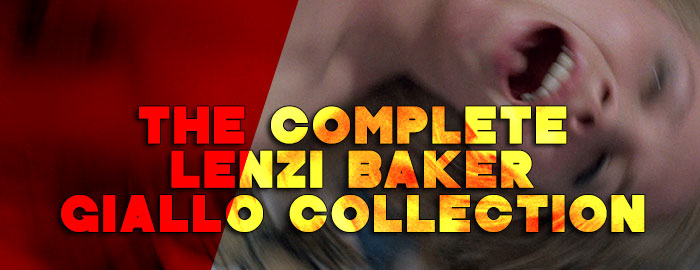
PARANOIA (ORGASMO)
Color, 1969, 97 mins. 1 sec. / 90 mins. 59 secs.
Directed by Umberto Lenzi
Starring Carroll Baker, Lou Castel, Colette Descombes, Tino Carraro
Severin Films (Blu-ray) (US R0 HD) / WS (2.35:1) (16:9)
SO SWEET... SO PERVERSE
Color, 1969, 93 mins. 25 secs.
Directed by Umberto Lenzi
Starring Carroll Baker, Jean-Louis Trintignant, Erika Blanc, Horst Frank, Helga Liné
Severin Films (Blu-ray) (US R0 HD) / WS (2.35:1) (16:9)
A QUIET PLACE TO KILL (PARANOIA)
Color, 1970, 93 mins.57 secs.
Directed by Umberto Lenzi
Starring Carroll Baker, Jean Sorel, Luis Dávila, Alberto Dalbés, Marina Coffa
Severin Films (Blu-ray) (US R0 HD), 88 Films (Blu-ray) (UK R0 HD), X-Rated Kult (Blu-ray) (Germany RB HD) / WS (2.35:1) (16:9)
KNIFE OF ICE
Color, 1972, 91 mins. 36 secs.
Directed by Umberto Lenzi
Starring Carroll Baker, Alan Scott, Evelyn Stewart, Eduardo Fajardo, Silvia Montelli, George Rigaud
Severin Films (Blu-ray) (US RA HD) / WS (2.35:1) (16:9)
Get  ready to be thoroughly confused. In 1967,
ready to be thoroughly confused. In 1967, 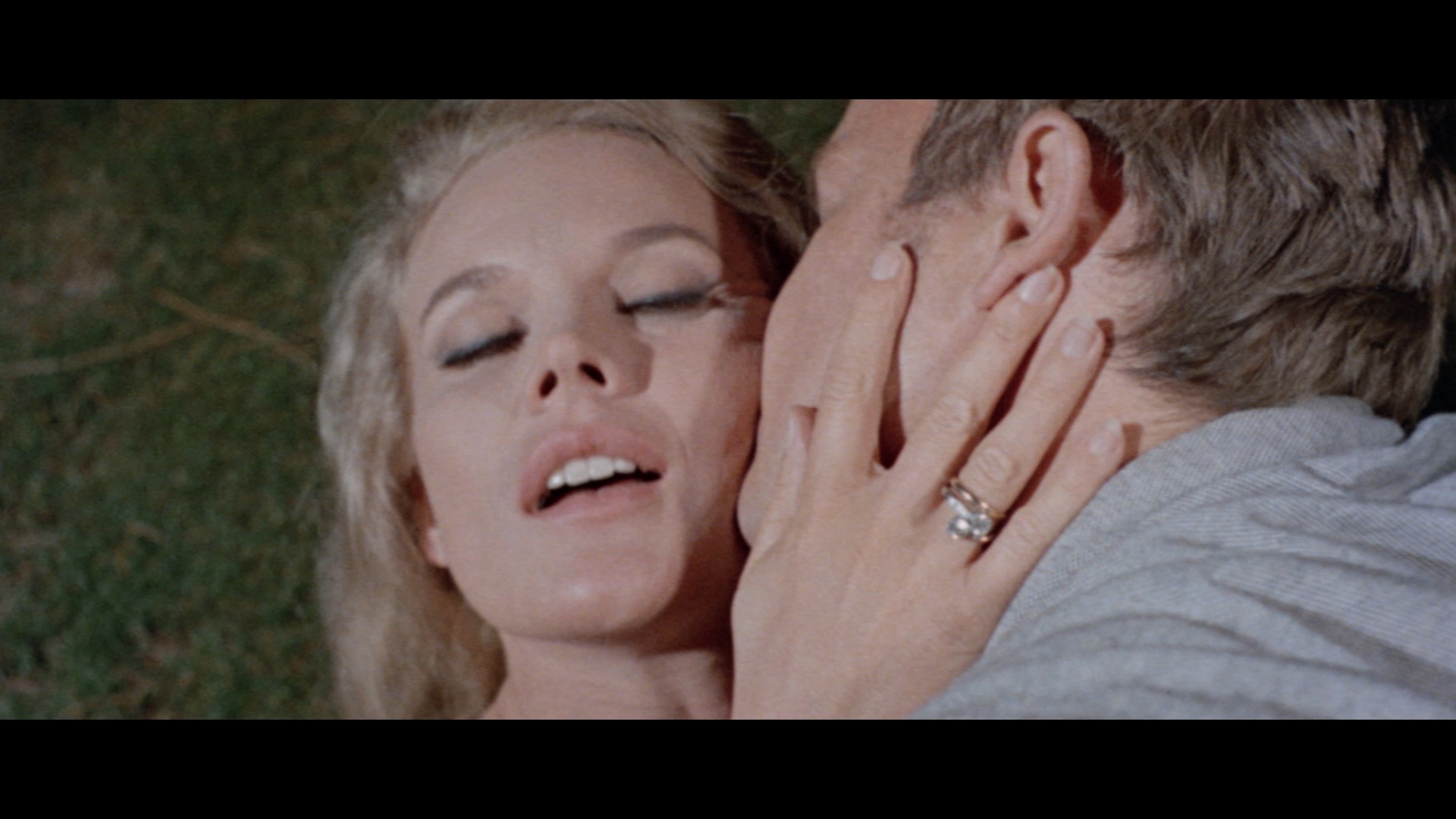 American star Carroll Baker made an abrupt career shift following soapy, glitzy Hollywood productions like The Carpetbaggers and Harlow to jet off to Italy where she started appearing in a string of sexy films starting off with Marco Ferreri's The Harem. She scored a significant international hit with her next Italian feature, 1968's The Sweet Body of Deborah, which paired her up with French heartthrob Jean Sorel and really kicked off the elegant cosmopolitan giallo that would remain the standard for a couple of years until Dario Argento upended all of it in 1970. Though the giallo had been around since the pioneering works of Mario Bava (thanks to The Girl Who Knew Too Much, Blood and Black Lace, and a third of Black Sabbath), the Baker film brought it to a new level of commercial accessibility including a hefty U.S. release from none other than Warner Bros. (in its Seven Arts phase).
American star Carroll Baker made an abrupt career shift following soapy, glitzy Hollywood productions like The Carpetbaggers and Harlow to jet off to Italy where she started appearing in a string of sexy films starting off with Marco Ferreri's The Harem. She scored a significant international hit with her next Italian feature, 1968's The Sweet Body of Deborah, which paired her up with French heartthrob Jean Sorel and really kicked off the elegant cosmopolitan giallo that would remain the standard for a couple of years until Dario Argento upended all of it in 1970. Though the giallo had been around since the pioneering works of Mario Bava (thanks to The Girl Who Knew Too Much, Blood and Black Lace, and a third of Black Sabbath), the Baker film brought it to a new level of commercial accessibility including a hefty U.S. release from none other than Warner Bros. (in its Seven Arts phase).
Later in '68, director Umberto Lenzi dove into the giallo pool with his first effort in the subgenre, Orgasmo, which starred Baker and also got very wide international distribution from Commonwealth United Entertainment, who also handled some Jess Franco films around the time like Venus in Furs. The American distributor decided that title was way too much for U.S. audiences so they retitled it Paranoia, added some spicier topless nude shots that earned it an early X rating (now easily an R), and lopped out a climactic twist in the story that essentially excised the film's giallo credentials almost entirely. The plot itself is essentially a groovy, sex-up variation on the Gaslight formula of driving an heiress mad for some nefarious reason, with Baker playing the victim, widowed socialite Kathryn West. Enter Peter (Castel) and Eva (Descombes), who claim to be siblings with the former prone to 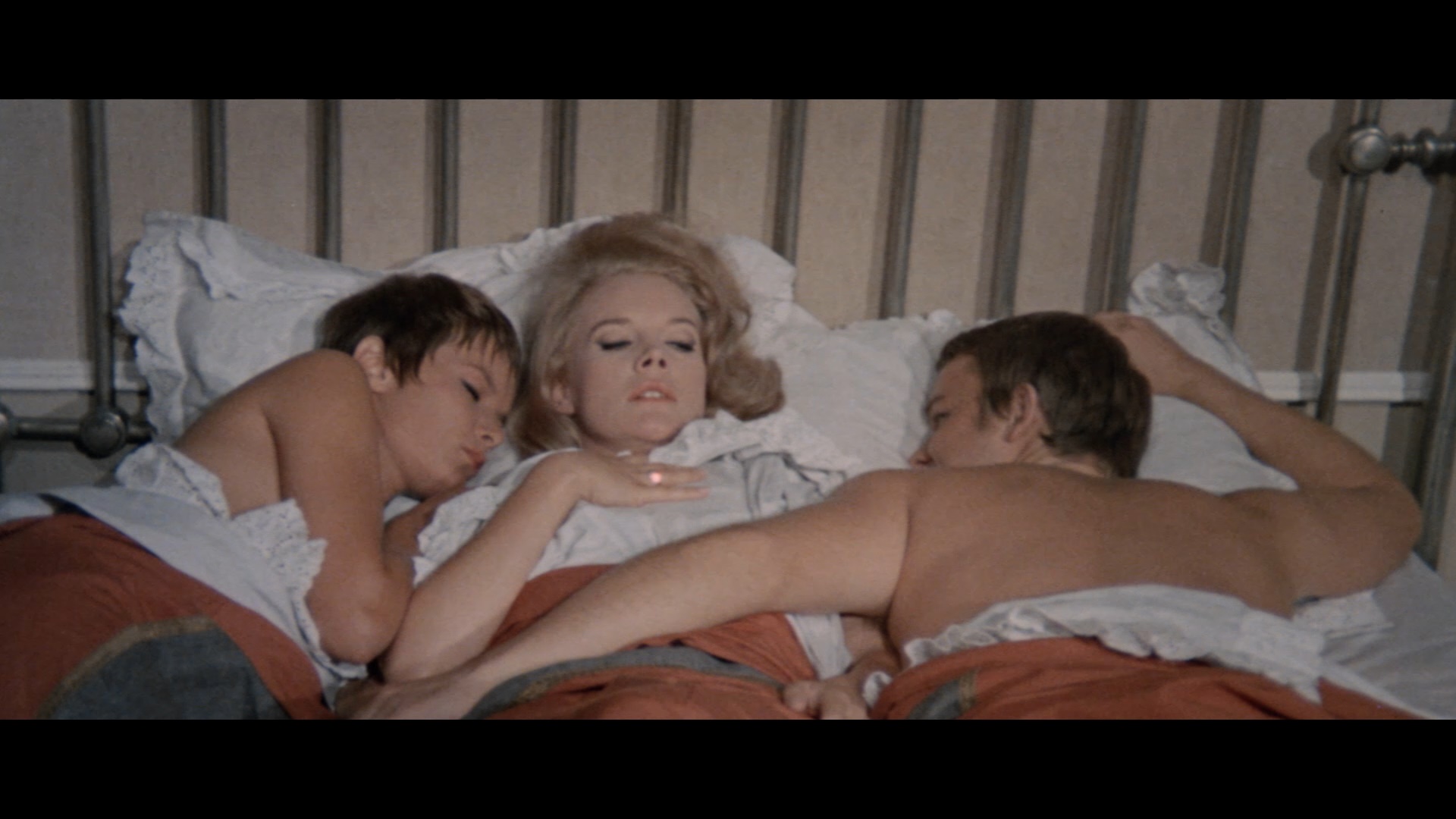 spouting Marxist ideology and seducing Kathryn whenever he has the chance. Of course, it soon
spouting Marxist ideology and seducing Kathryn whenever he has the chance. Of course, it soon 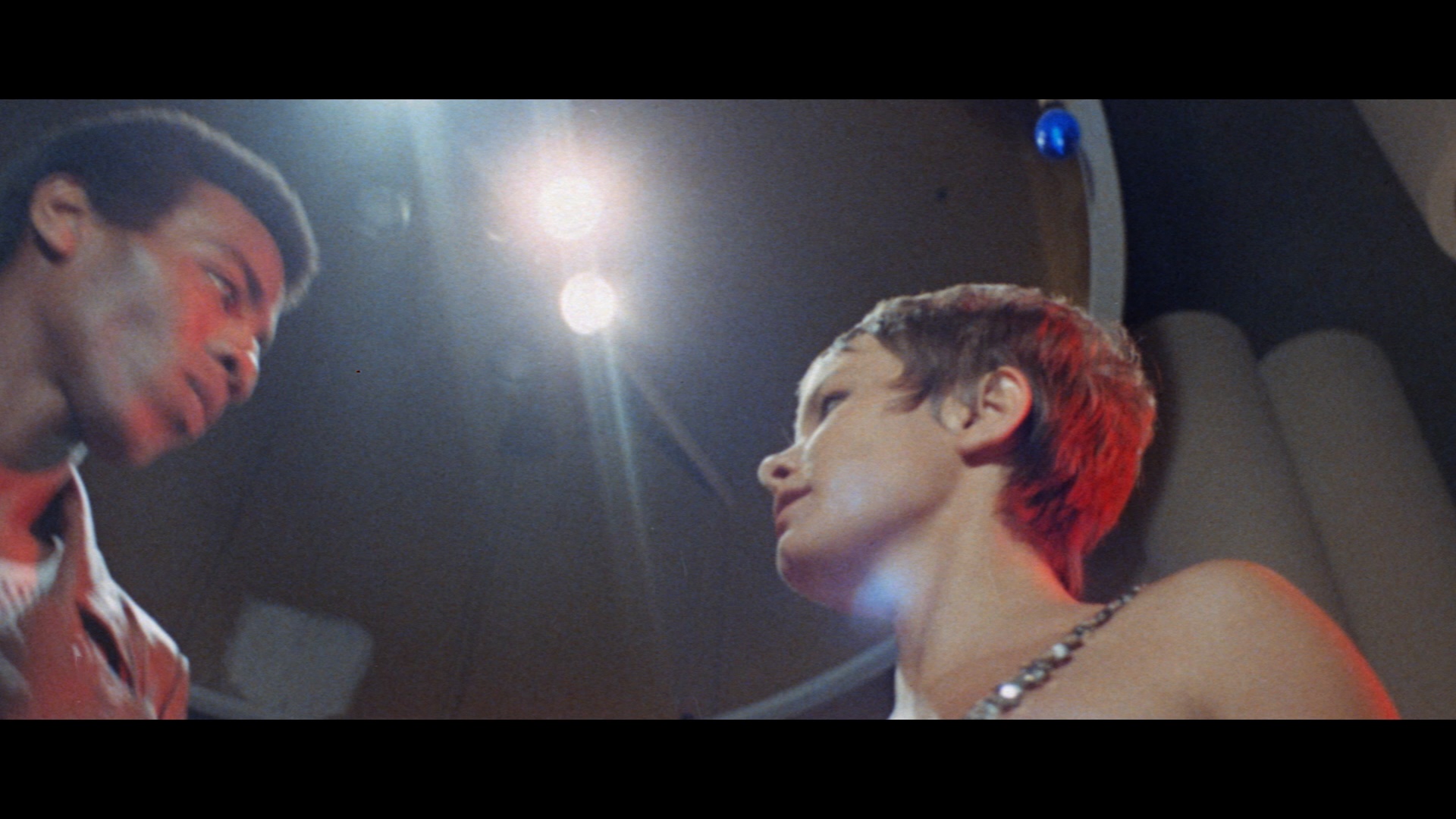 becomes a perverse love triangle with the seemingly innocent Eva's true colors coming out and Kathryn becoming a prisoner in her own home after the partying and drinking have died down.
becomes a perverse love triangle with the seemingly innocent Eva's true colors coming out and Kathryn becoming a prisoner in her own home after the partying and drinking have died down.
Elegant and stylish, Paranoia is an exceedingly well-mounted film and a perfect calling card for Lenzi with the actress who would go on to star in three subsequent projects for him. Baker is game as always, allowing herself to get more than a little mussed up in the final stretch and doing the kind of peekaboo nudity that was enough to pull in significant crowds at the time. Adding to the fun is an infectious lounge score by Piero Umiliani, who was really on a roll at the time giallo-wise between this, Death Knocks Twice, and his all-time masterpiece in the category, Five Dolls for an August Moon. Interestingly, the score actually plays a role in the plot with the vocal version of one of its two primary themes, "Just Tell Me" (by Wes and the Airdales, who also made a musical cameo in Don't Torture a Duckling), serving as an instrument of psychological torture. The actual violence level here is extremely low (with virtually all of it occurring in the last few minutes), but the psychological tension runs high and the cast makes the most of their characters from start to finish. In short, it's no wonder this one made such an impression and helped revive the giallo from a very early death.
The home video history of Paranoia has been somewhat inexplicable since its initial VHS release in the U.S. from NTA (an early imprint of Republic). Still bearing that X rating (which no doubt confused a lot of video renters), it contained the standard U.S. cut panned and scanned so badly it was impossible to follow a few key scenes. It wasn't obvious for English-speaking how severely the film had been doctored until a 1990s Australian TV broadcast of the Italian version, partially letterboxed at 1.85:1 and featuring English subtitles. At last the 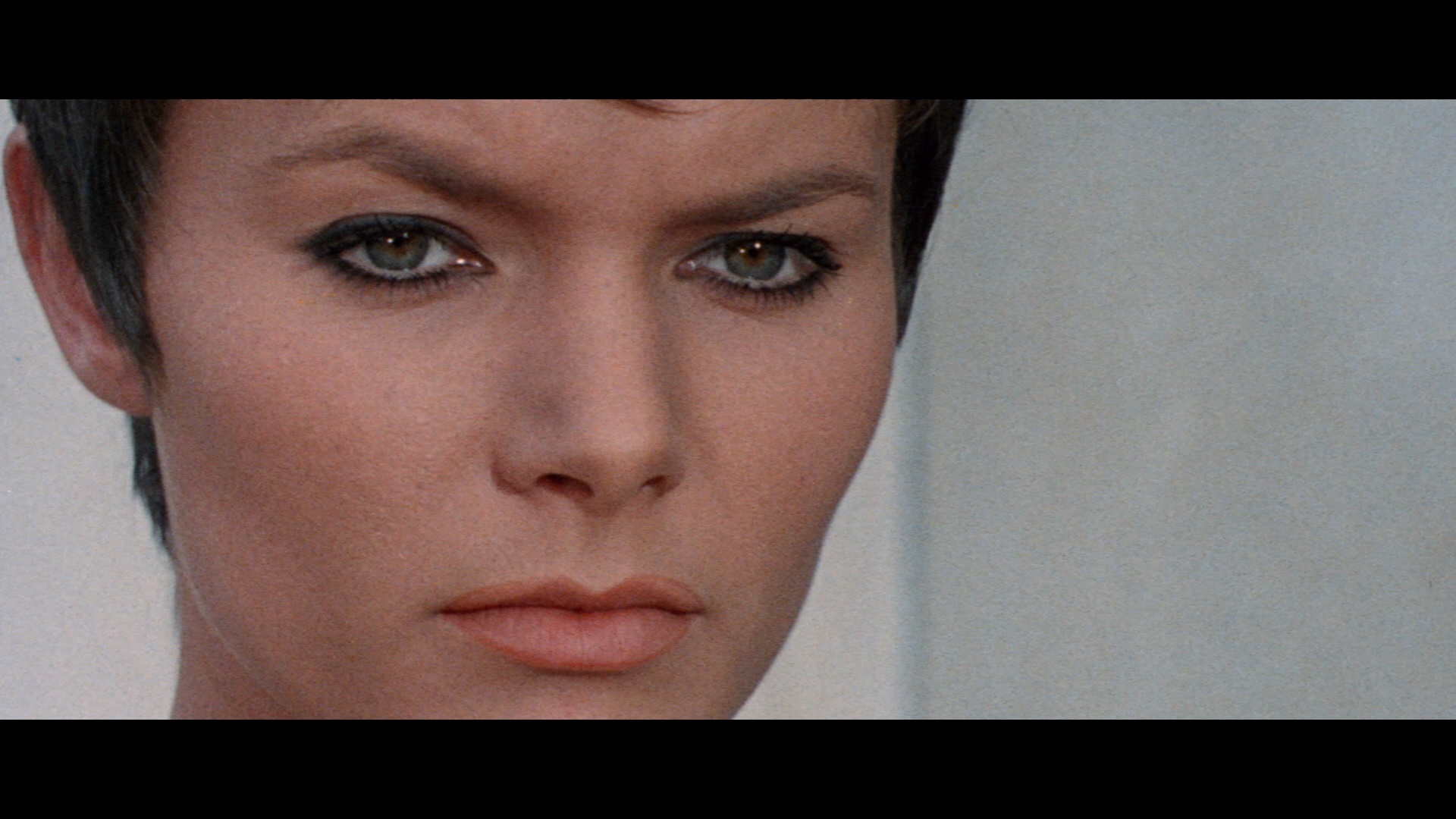 story made a lot more sense instead of the abrupt and almost hysterically depressing resolution of the U.S. cut, and that version was later
story made a lot more sense instead of the abrupt and almost hysterically depressing resolution of the U.S. cut, and that version was later 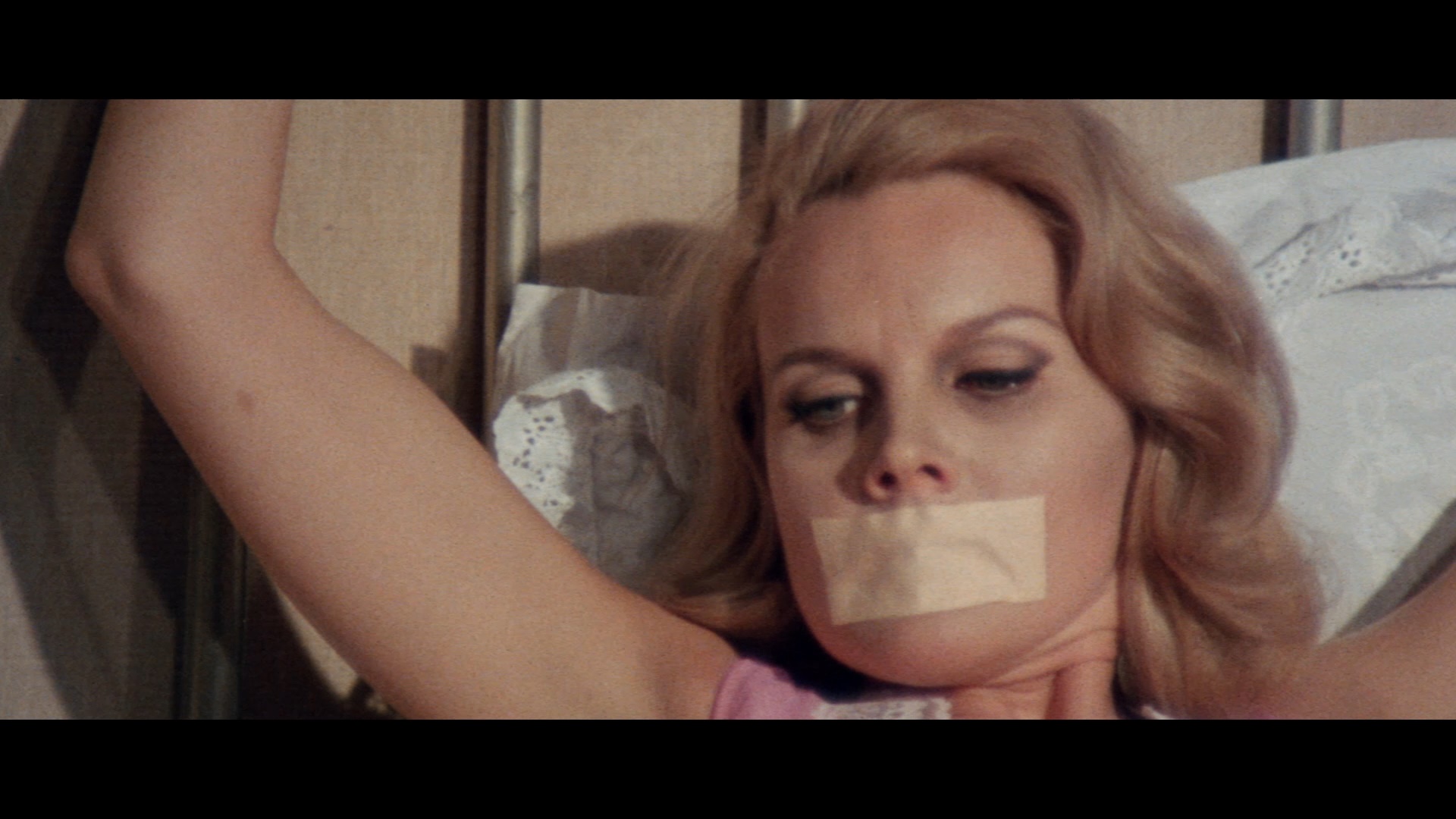 issued on Italian DVD (albeit with no English-friendly options at all). After that it was a long, long wait until the 2020 Blu-ray debut from Severin Films as part of the limited, six-disc set, The Complete Lenzi Baker Giallo Collection, which compiles all four of their features along with two bonus CDs. (The set is also available as a limited bundle featuring a T-shirt and postcards, while early orders also got an Italian comic reproduction for the second film in the set.) The first CD contains, for the first time ever in any format, the full soundtrack for Paranoia; prior to this we only had the two songs ("Just Tell Me" and Lydia MacDonald's "Fate Had Planned It So") as scarce Italian 45 vinyl singles, but now you get everything including the entire Umiliani score (with most of it in gorgeous stereo). A miracle of rights hurdling on so many fronts, the box is an obvious labor of love that brings together a cycle that many had given up ever seeing being given the deluxe treatment anywhere in the world, and to start things off right, Paranoia is presented in full scope in both its Italian and U.S. cuts for the first time anywhere. Even better, you can finally watch the Italian cut at last with option of an English track integrated wherever possible with subtitled Italian used for that original extended ending. The Italian audio is also present with optional English translated subtitles, while the U.S. cut comes with English SDH subtitles. Shot in Techniscope and most often seen over the past few decades in terrible, ragged prints, this film doesn't look as polished or slick as its successors with fading, chunkiness, and softness in evidence, but this is easily the best it's ever looked on home video and far superior to the very mangled surviving U.S. prints barely floating around out there. The two audio commentaries it contains can't really be evaluated here as one of them (for the U.S. cut) features this writer and Troy Howarth but you will hopefully find it enjoyable; the Italian version comes with an audio commentary by Alexandra Heller-Nicholas who focuses on rebutting the labeling of Lenzi as a hack and chats about the origins of the giallo. In "Giallo Fever" (11m1s), an interview with the late Lenzi covers the development of the script, the French involvement, the story behind the title change (complicated by the fact that this was originally intended to be called Paranoia before the Italian producer
issued on Italian DVD (albeit with no English-friendly options at all). After that it was a long, long wait until the 2020 Blu-ray debut from Severin Films as part of the limited, six-disc set, The Complete Lenzi Baker Giallo Collection, which compiles all four of their features along with two bonus CDs. (The set is also available as a limited bundle featuring a T-shirt and postcards, while early orders also got an Italian comic reproduction for the second film in the set.) The first CD contains, for the first time ever in any format, the full soundtrack for Paranoia; prior to this we only had the two songs ("Just Tell Me" and Lydia MacDonald's "Fate Had Planned It So") as scarce Italian 45 vinyl singles, but now you get everything including the entire Umiliani score (with most of it in gorgeous stereo). A miracle of rights hurdling on so many fronts, the box is an obvious labor of love that brings together a cycle that many had given up ever seeing being given the deluxe treatment anywhere in the world, and to start things off right, Paranoia is presented in full scope in both its Italian and U.S. cuts for the first time anywhere. Even better, you can finally watch the Italian cut at last with option of an English track integrated wherever possible with subtitled Italian used for that original extended ending. The Italian audio is also present with optional English translated subtitles, while the U.S. cut comes with English SDH subtitles. Shot in Techniscope and most often seen over the past few decades in terrible, ragged prints, this film doesn't look as polished or slick as its successors with fading, chunkiness, and softness in evidence, but this is easily the best it's ever looked on home video and far superior to the very mangled surviving U.S. prints barely floating around out there. The two audio commentaries it contains can't really be evaluated here as one of them (for the U.S. cut) features this writer and Troy Howarth but you will hopefully find it enjoyable; the Italian version comes with an audio commentary by Alexandra Heller-Nicholas who focuses on rebutting the labeling of Lenzi as a hack and chats about the origins of the giallo. In "Giallo Fever" (11m1s), an interview with the late Lenzi covers the development of the script, the French involvement, the story behind the title change (complicated by the fact that this was originally intended to be called Paranoia before the Italian producer 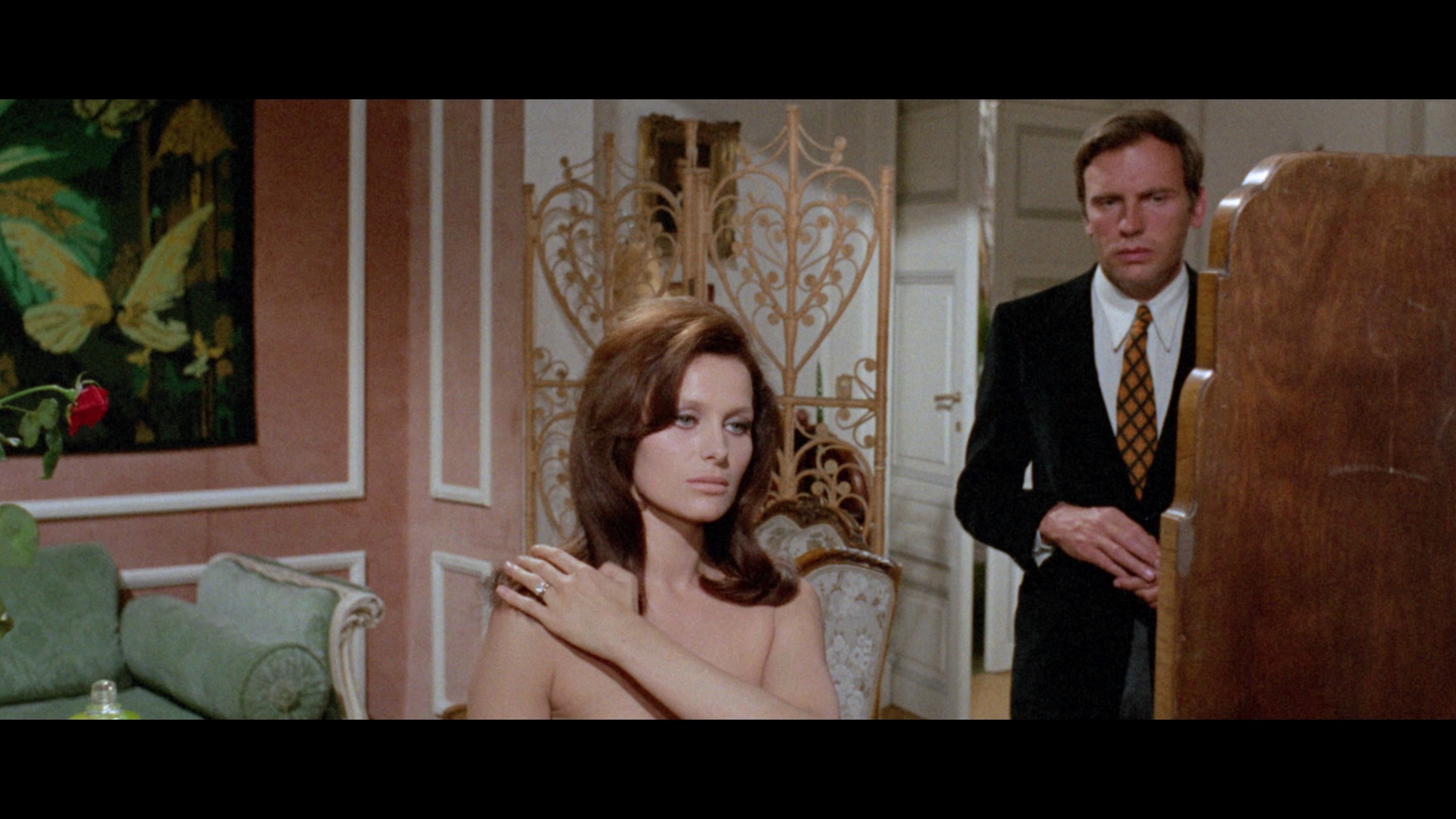 went for Orgasmo instead), and a few amusing additional tangents about his creative process
went for Orgasmo instead), and a few amusing additional tangents about his creative process 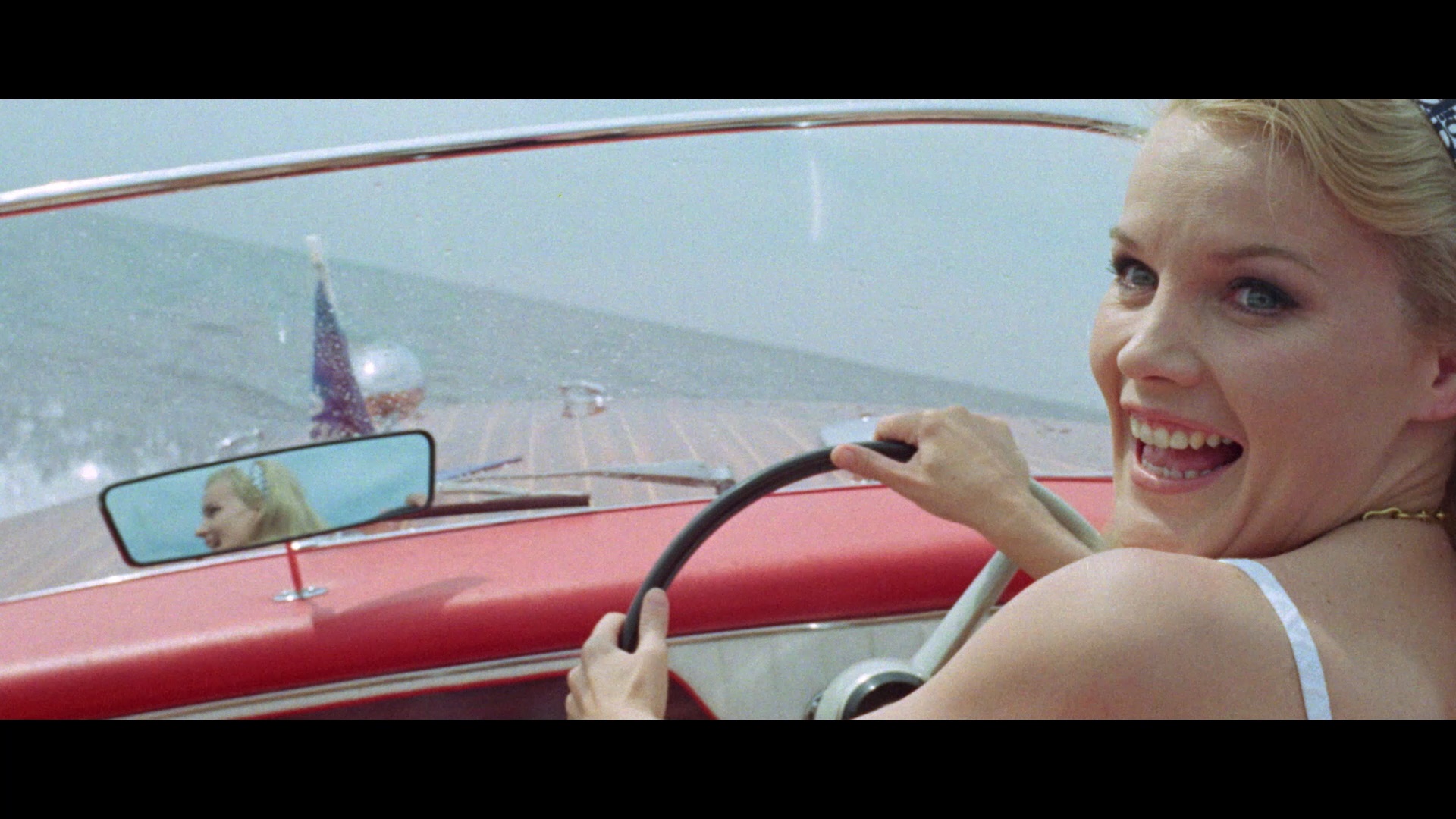 on other films like Kriminal and Brothers Till We Die. The U.S. trailer is also included.
on other films like Kriminal and Brothers Till We Die. The U.S. trailer is also included.
The success of Paranoia ensured a quick reteaming of Lenzi and Baker for another film released later the same year: So Sweet... So Perverse (not to be confused with the later and much trashier So Sweet, So Dead), which amps up the elegance and plot twists while toning down the eroticism a bit for another story of jet setters stabbing each other in the back (mostly figuratively). This time the star power also amps up with leading man duties going to Jean-Louis Trintignant, in the midst of his brief giallo binge along with Death Laid an Egg and Deadly Sweet. On top of that you get a very welcome parade of familiar Euro genre faces including the always welcome Erika Blanc (who appeared in the first sorta-Emmanuelle film the same year and went on to turn heads in The Devil's Nightmare and The Night Evelyn Came Out of the Grave), Horst Frank (just before The Cat o' Nine Tails), and Helga Liné, a major figurehead of Spanish and Italian genre cinema.
If the previous film was inspired by Gaslight and some of the early home invasion films like Lady in a Cage, Kitten with a Whip, and The Desperate Hours, this one seems to be taking a cue from Diabolique with its parade of infidelities, double crosses, and possibly faked deaths. Trintignant stars as Jean, a skeet-shooting philanderer who's currently sharing the bed of married Helene (Liné) during the afternoons when he isn't focusing on his wife, Danielle (Blanc), who seems to mostly sit around undressed in front of mirrors. The intrigue kicks in when skittish Nicole (Baker) becomes his new upstairs neighbor, igniting a new affair complicated by her recent release from a mental hospital and the presence of her ongoing stalker, Klaus (Frank). As Jean becomes infatuated with the new arrival and contemplates a major change 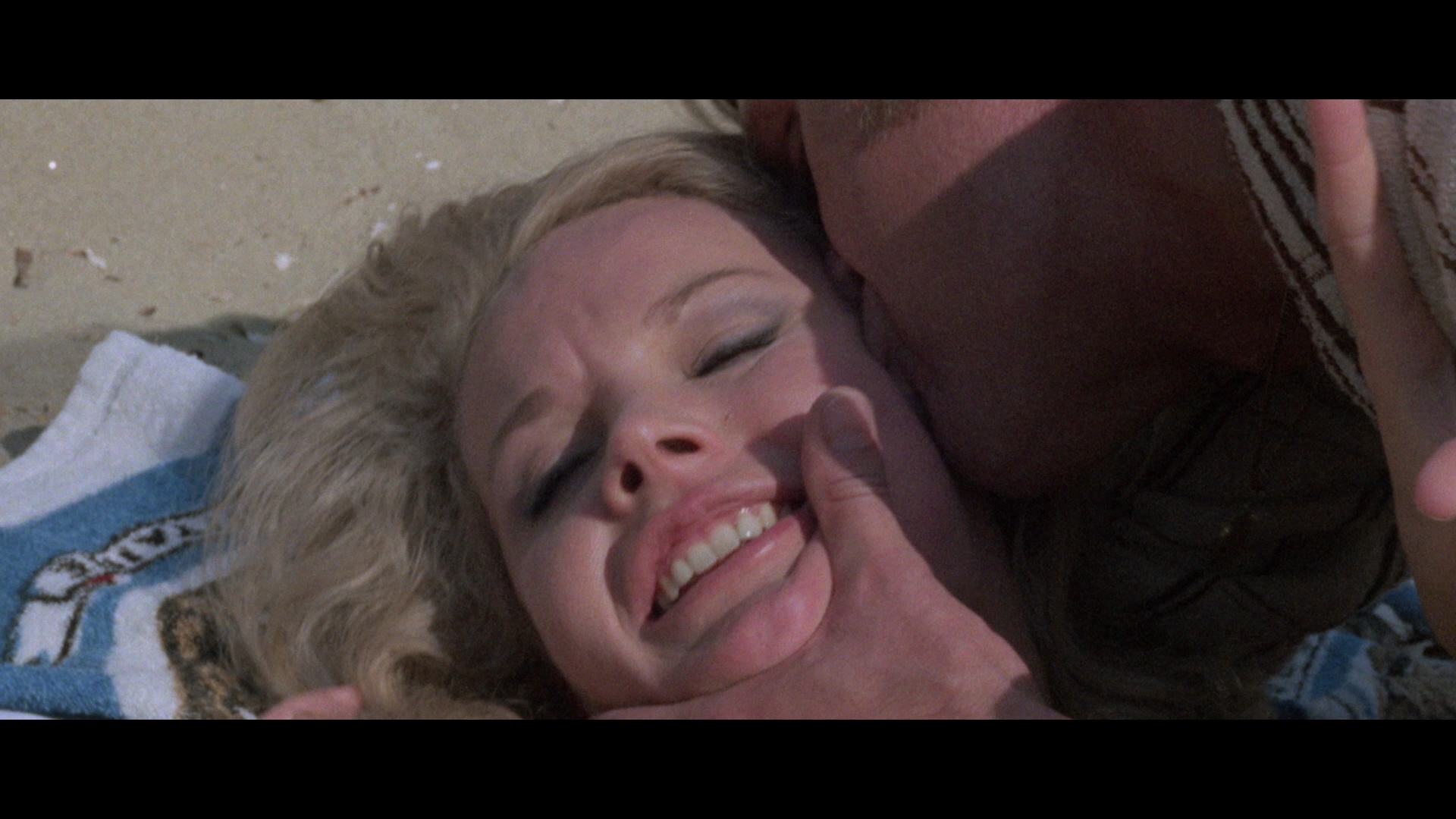 in his marital status, it soon turns out that there's
in his marital status, it soon turns out that there's 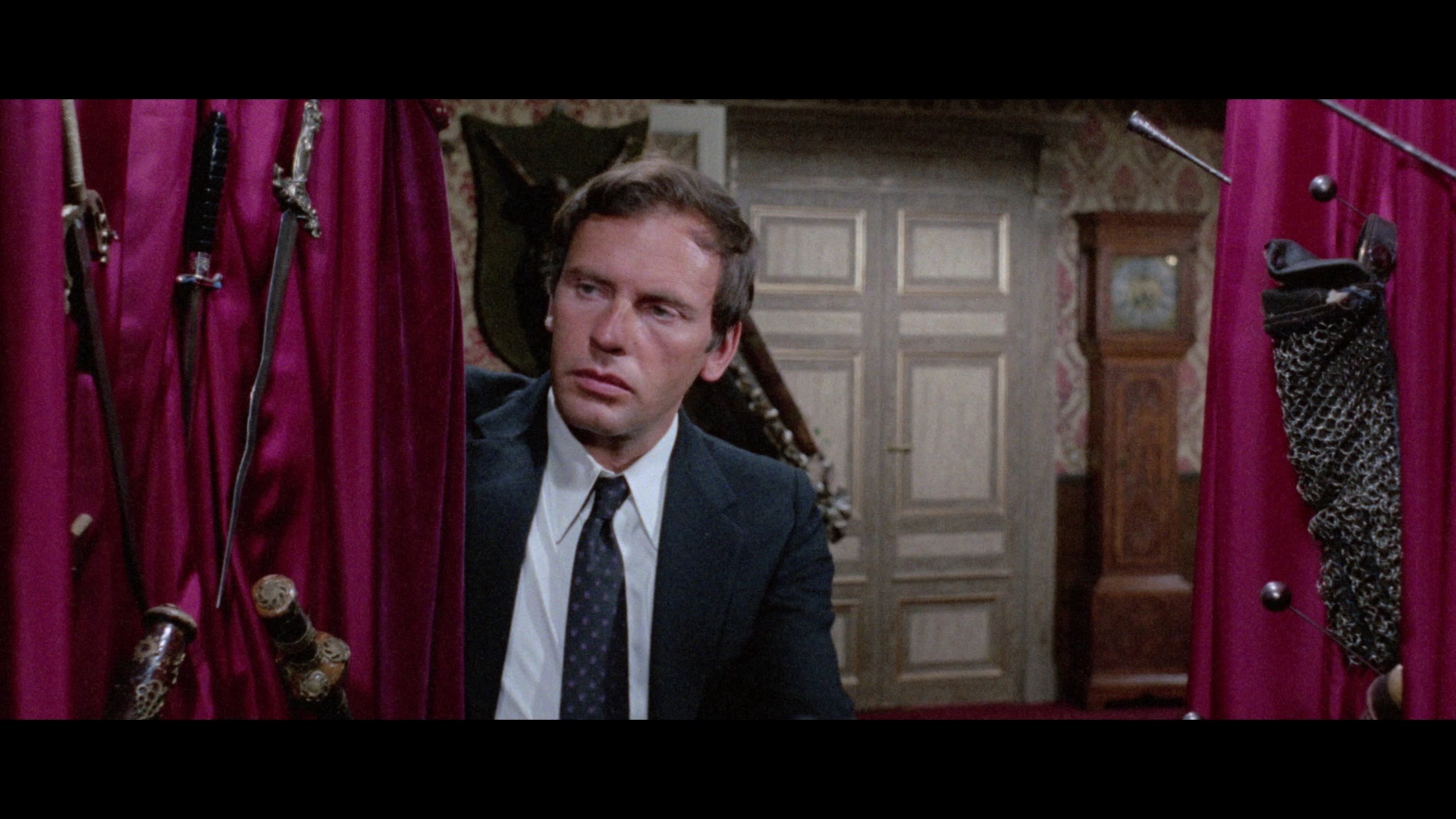 something far more deadly at work behind the scenes.
something far more deadly at work behind the scenes.
Produced by Luciano Martino before his brother Sergio got into the giallo game, this particular film stands out due to the screenplay by the insanely prolific screenwriter Ernesto Gastaldi who loads this up with an insane number of whiplash plot twists and location changes. The result falls far more into the traditional realm than Paranoia as a straight-up murder mystery, and composer Riz Ortolani gives the whole confection just the right amount of swanky style with his memorable score built around a haunting theme song, "Why" (which later turned up again in Lenzi's Seven Blood-stained Orchids). The film moves along at a steady clip, starting off as an elaborate tale of infidelity and domestic drama before morphing into a complex murder puzzle that culminates in an unusually ambiguous and haunting final scene that's easily the most resonant of the four films.
Despite the caliber of talent involved across the board, this film never had an official U.S. home video release of any kind until the 2020 edition from Severin Films. (Some shoddy gray market copies are around out there and should be avoided at all costs.) Anyone who's tried to suffer through earlier Euro-sourced VHS transfers of this one (or the Sony Italy DVD release from 2008, which wasn't English friendly) will be stunned at the quality here with plentiful vibrant colors on display. Excellent detail, natural film grain, deep black levels, and proper scope framing make this a real joy to watch and should hopefully put this on the radar of anyone who dismissed it in the past as another typical swanky, gore-free giallo. As this was shot in the relatively cheap Chromoscope process, the film can look a bit chunky at times (mainly in a handful of close ups) but that's part of the original format.  Audio is
Audio is  provided in English and Italian DTS-HD MA mono options with optional English-translated or English SDH subtitles; the English track is going to be preferable for most viewers since some (but not all) of the actors provide their own voices and were speaking English on the set, but the Italian version has its own points of interest including more poetic dialogue and a few variations in meaning with some of the line deliveries. The film can also be played with a new audio commentary by Kat Ellinger, who absolutely knocks it out of the park here; it's one of her very best giallo-centric tracks with an upbeat, razor-sharp focus on the film that encompasses connections to Lenzi's non-genre cinema, the parallels between Baker's own nervous breakdowns compared to her character's back story here, the importance of Gastaldi's narrative, and the merits of these often overlooked films in between the heydays of Bava and Argento. Engaged, perceptive, and entertaining, it's a great way to increase your appreciation of this film on numerous fronts. As for video extras, "Lenzi's Lenses" (9m5s) is a "backstage chat" with the director at the 1999 Nocturno Film Festival, chatting about shooting the film in Paris, the importance of Italian-French teamings in his career, his favorite actors and genres, and this title's particular significance in his memory including his issues with the later stretch of the location shooting. Then the brief "Equilateral Triangle" (5m59s) features Gastaldi recalling his somewhat turbulent relationship with the Tuscan director who had become "touchy and tense" at the height of his career. Also tucked away in the main menu (and barely hidden) is a reel of Italian newsreel and TV coverage (7m30s) on Baker focusing on her portrayal of Jean Harlow and Baby Doll. Finally you get the English and Italian trailers and the Italian main titles.
provided in English and Italian DTS-HD MA mono options with optional English-translated or English SDH subtitles; the English track is going to be preferable for most viewers since some (but not all) of the actors provide their own voices and were speaking English on the set, but the Italian version has its own points of interest including more poetic dialogue and a few variations in meaning with some of the line deliveries. The film can also be played with a new audio commentary by Kat Ellinger, who absolutely knocks it out of the park here; it's one of her very best giallo-centric tracks with an upbeat, razor-sharp focus on the film that encompasses connections to Lenzi's non-genre cinema, the parallels between Baker's own nervous breakdowns compared to her character's back story here, the importance of Gastaldi's narrative, and the merits of these often overlooked films in between the heydays of Bava and Argento. Engaged, perceptive, and entertaining, it's a great way to increase your appreciation of this film on numerous fronts. As for video extras, "Lenzi's Lenses" (9m5s) is a "backstage chat" with the director at the 1999 Nocturno Film Festival, chatting about shooting the film in Paris, the importance of Italian-French teamings in his career, his favorite actors and genres, and this title's particular significance in his memory including his issues with the later stretch of the location shooting. Then the brief "Equilateral Triangle" (5m59s) features Gastaldi recalling his somewhat turbulent relationship with the Tuscan director who had become "touchy and tense" at the height of his career. Also tucked away in the main menu (and barely hidden) is a reel of Italian newsreel and TV coverage (7m30s) on Baker focusing on her portrayal of Jean Harlow and Baby Doll. Finally you get the English and Italian trailers and the Italian main titles.
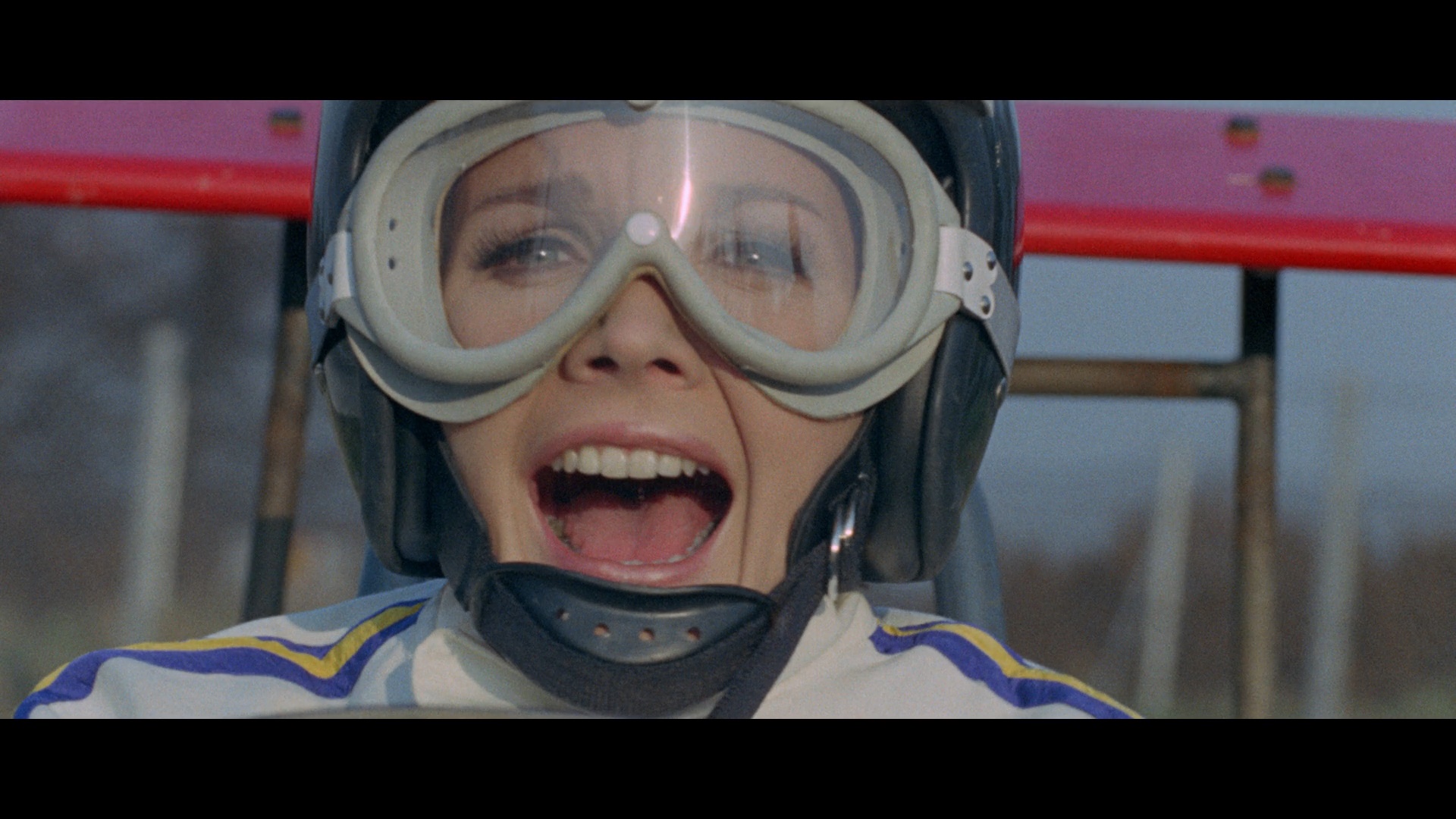 In 1970,
In 1970, 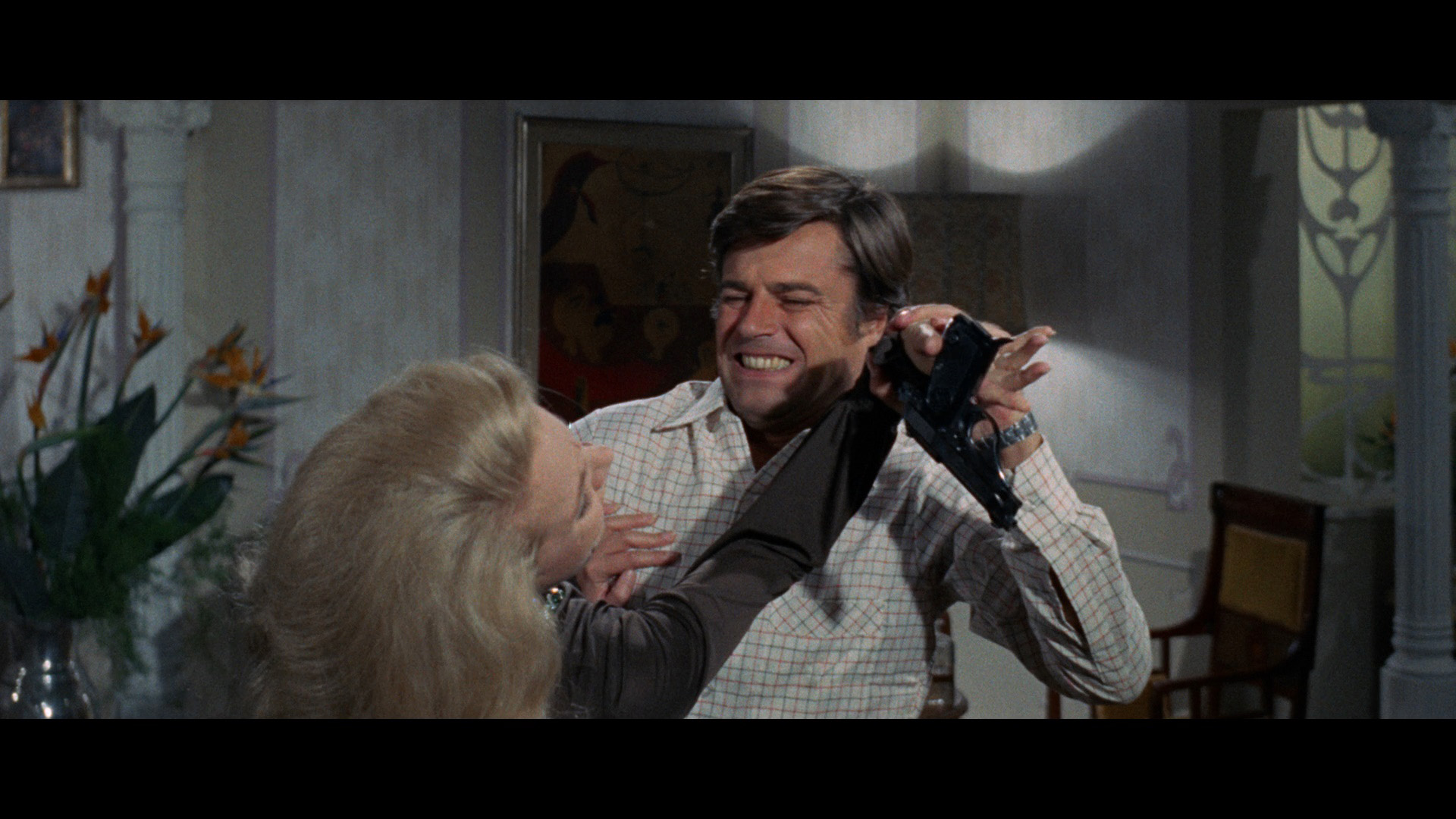 Lenzi and Baker really started confusing everyone by making a third giallo whose Italian title was Paranoia, a concession to that earlier film's success in America. On top of that, this film brought Baker and Sorel back together after Sweet Body and reused a key song from Orgasmo, "Just Tell Me;" for the American release, the distributor did their best to distinguish this new film by calling it A Quiet Place to Kill. Apparently determined to wreak as much havoc on viewers' sanity as possible, Lenzi followed this up with a non-Baker giallo, An Ideal Place to Kill, which had a role originally written for Baker (ultimately played by Irene Papas) and basically retold the story of Orgasmo from the two counterculture kids' point of view.
Lenzi and Baker really started confusing everyone by making a third giallo whose Italian title was Paranoia, a concession to that earlier film's success in America. On top of that, this film brought Baker and Sorel back together after Sweet Body and reused a key song from Orgasmo, "Just Tell Me;" for the American release, the distributor did their best to distinguish this new film by calling it A Quiet Place to Kill. Apparently determined to wreak as much havoc on viewers' sanity as possible, Lenzi followed this up with a non-Baker giallo, An Ideal Place to Kill, which had a role originally written for Baker (ultimately played by Irene Papas) and basically retold the story of Orgasmo from the two counterculture kids' point of view.
Now that you've got all that, A Quiet Place to Kill is a fine, sparkling thriller with Baker and Sorel managing to recapture the spark of their previous work together. Here Baker is Helen, a race car driver who suffers a significant crash on the racetrack. She's invited by Susan (Coffa) to stay at a swanky Mediterranean beach-side home, but Susan happens to be married to Helen's ex, Maurice (Sorel), who may or may not have been an abusive brute depending on how much we can take Helen's flashbacks at face value. As it turns out, Susan can't stand Maurice either and wants him out of the picture-- but she can only do it with Helen's help. Of course, that turns out to be just the beginning of a twisty plot loaded with double crosses and whiplash turns.
Once again this one has Diabolique written all over it (plus a heavy splash of Rene Clement's Purple Noon) but really works best as a sumptuous European cinematic getaway with beautiful stars doing indulgent things day and night by the sea. Baker and Sorel still make for a magnetic pair, of course, and this time out the Spanish co-financing is far more obvious thanks to virtually the entire supporting cast (plus a juicy role for Argentinian Luis Dávila just after Eagles Over London) and a fun, loungy score by Gregorio 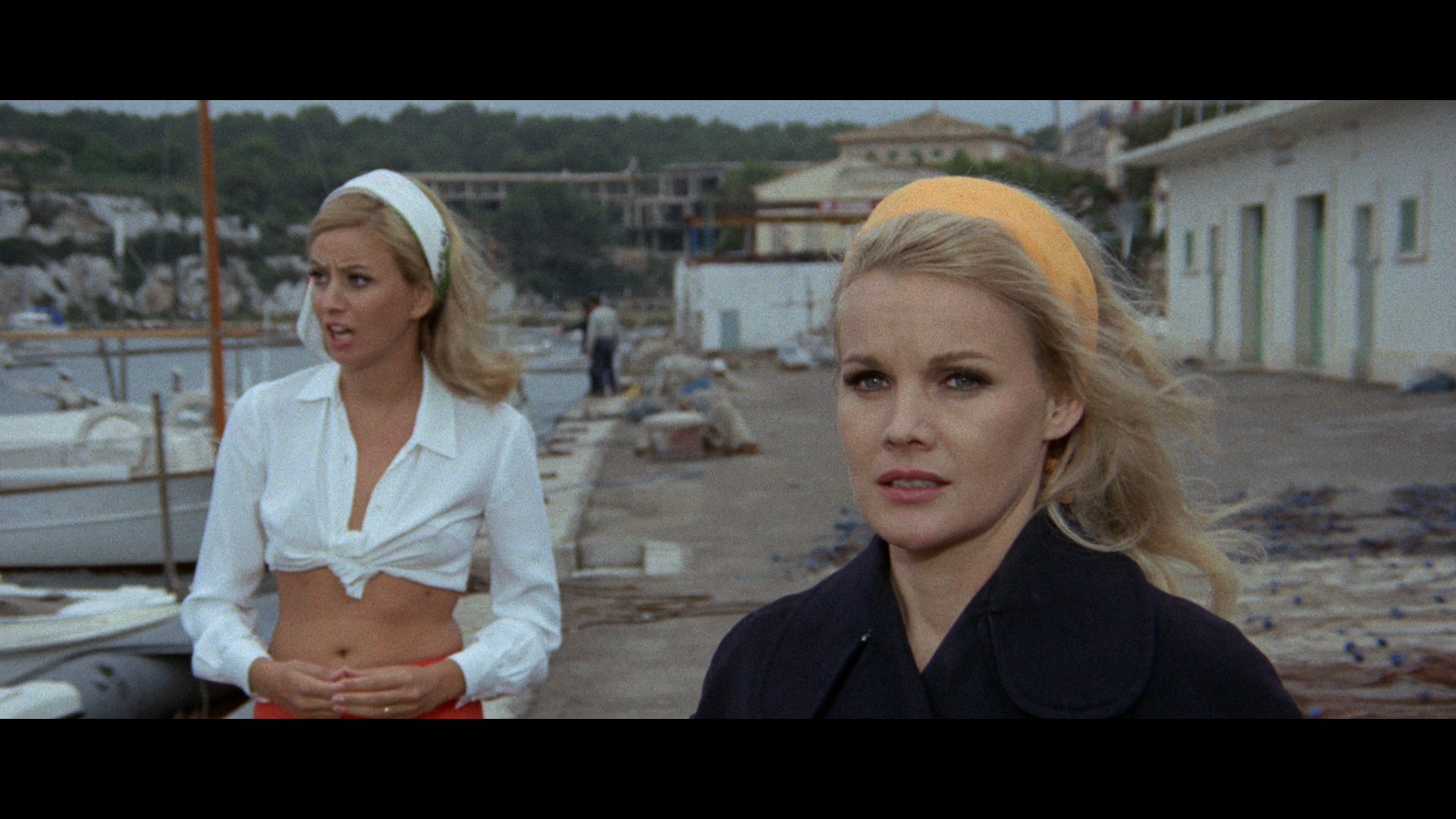 García Segura complete with the obligatory theme song, in this case "You" performed by Canadian singer-actress Shirley Harmer. It's worth noting that this opened shortly
García Segura complete with the obligatory theme song, in this case "You" performed by Canadian singer-actress Shirley Harmer. It's worth noting that this opened shortly 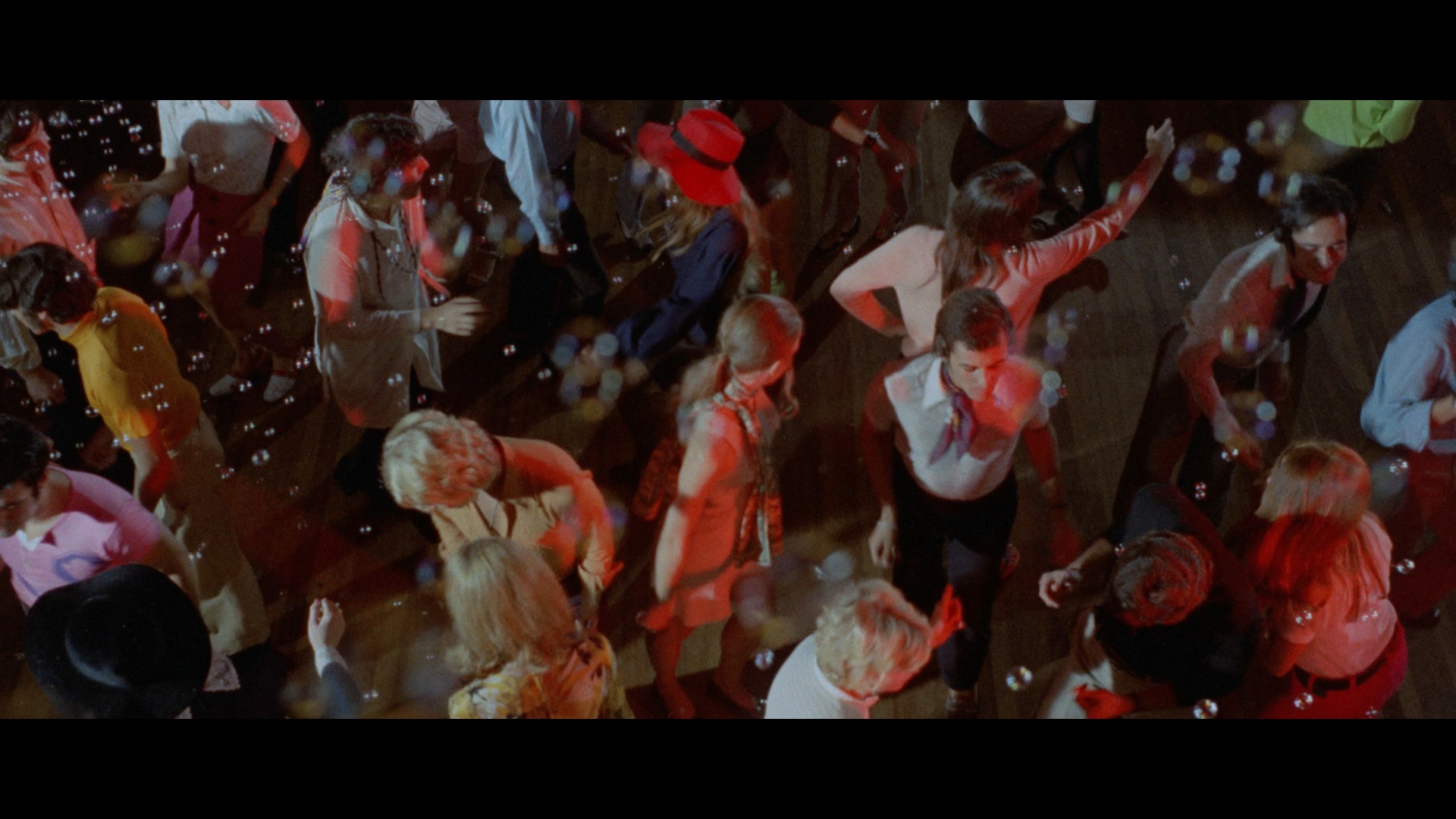 before Sergio Martino's first giallo, The Strange Vice of Mrs. Wardh, which feels very much like an evolution of the Lenzi cycle with the sex and violence amped up a bit to keep up with the times. Interestingly, this one also features way more exposure of Ms. Baker than the more famous, other Paranoia, though some audiences (and VHS consumers) got prints with alternate clothed takes of a few shots in keeping with Spanish cinematic practice at the time.
before Sergio Martino's first giallo, The Strange Vice of Mrs. Wardh, which feels very much like an evolution of the Lenzi cycle with the sex and violence amped up a bit to keep up with the times. Interestingly, this one also features way more exposure of Ms. Baker than the more famous, other Paranoia, though some audiences (and VHS consumers) got prints with alternate clothed takes of a few shots in keeping with Spanish cinematic practice at the time.
Initially released on American VHS by Unicorn in a heavily cropped transfer (as A Quiet Place to Kill) that butchered the entire look of the film, Paranoia really needs to be seen at its full width for any kind of appreciation whatsoever. The first Blu-ray appeared in 2018 from X-Rated Kult in Germany, featuring the German and Italian tracks with optional German and English subtitle options. Unfortunately the absent English track is the preferable option as it maintains Baker's original vocal performance and fits the other actors' line readings, but at least it's English friendly in some way. The very expensive release also comes with a commentary by Troy Howarth. In early 2020, 88 Films brought the film to U.K. Blu-ray as a limited edition featuring a "soft touch" slipcase, reversible sleeve art, and an insert booklet with liner notes by Rachael Nisbet. Though the German version wasn't available for comparison, the 2.35:1 transfer here looks great with some wonderfully gaudy colors throughout (especially the wild cave party and nightclub sequences). The main presentation features the Italian titles and is the saucier version with all the nudity intact; audio options are English or Italian mono (DTS-HD MA) with optional English (translated) subtitles and both sound excellent. You also get a Howarth commentary here, but it isn't the same as the German one; in fact, he kicks things off by noting the importance of the English track and its absence on the prior Blu-ray. After that it's off to the races as he chats about the giallo conventions of the era, the more assertive nature of Baker's character here, Lenzi's place in the subgenre's history, the shared cinematic DNA with some of the British thrillers coming out around the same time, and the backgrounds of all the key players. In the featurette "Imperfect Crime" (14m50s), Lenzi chats about the film and his Baker movie cycle, noting that he stayed in touch with her for decades and going into the title confusion that plagues his work from this period. He also notes the location shooting in Palma de Mallorca and his dealings with the Spanish cast and crew as 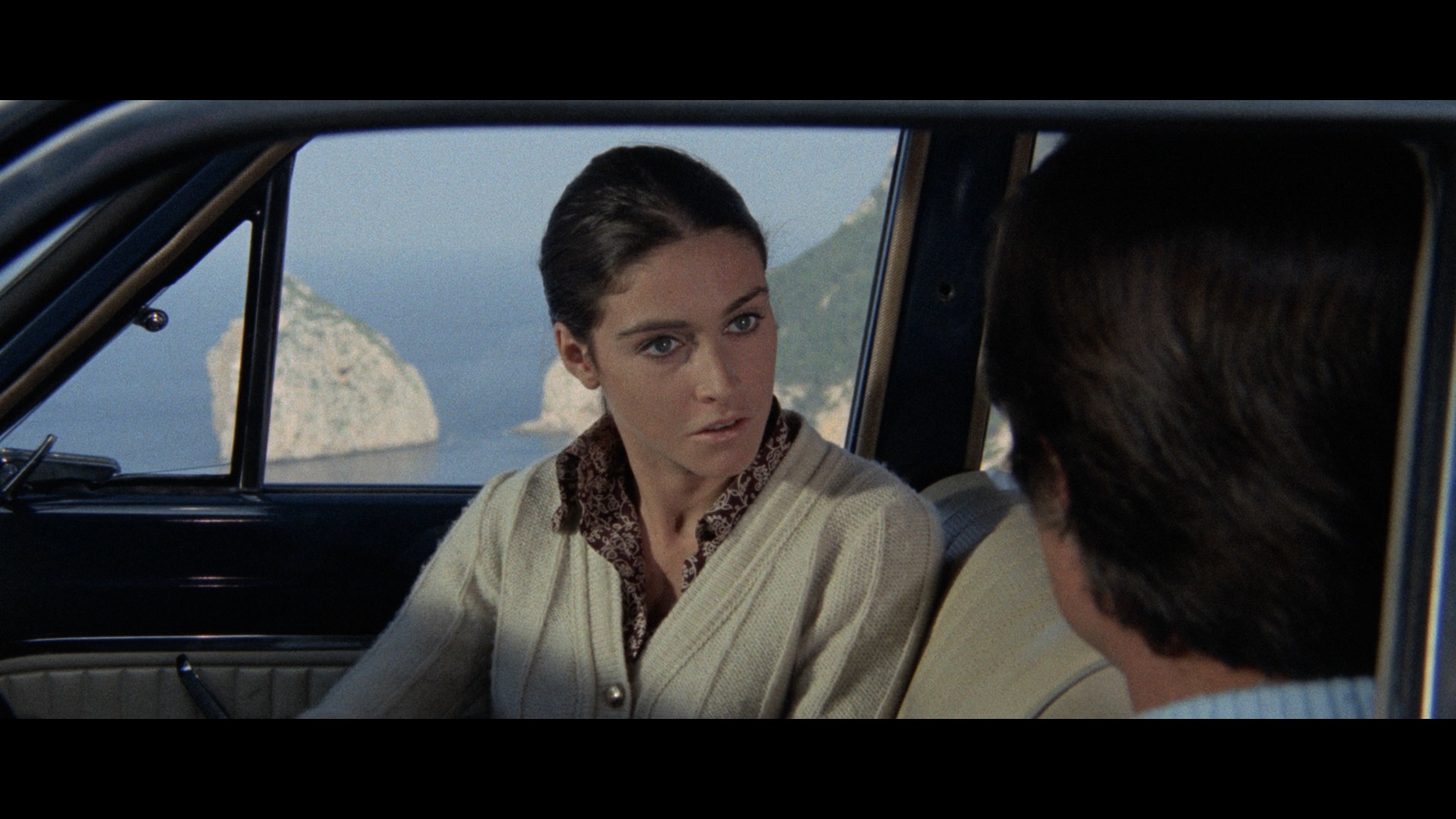 well as the
well as the 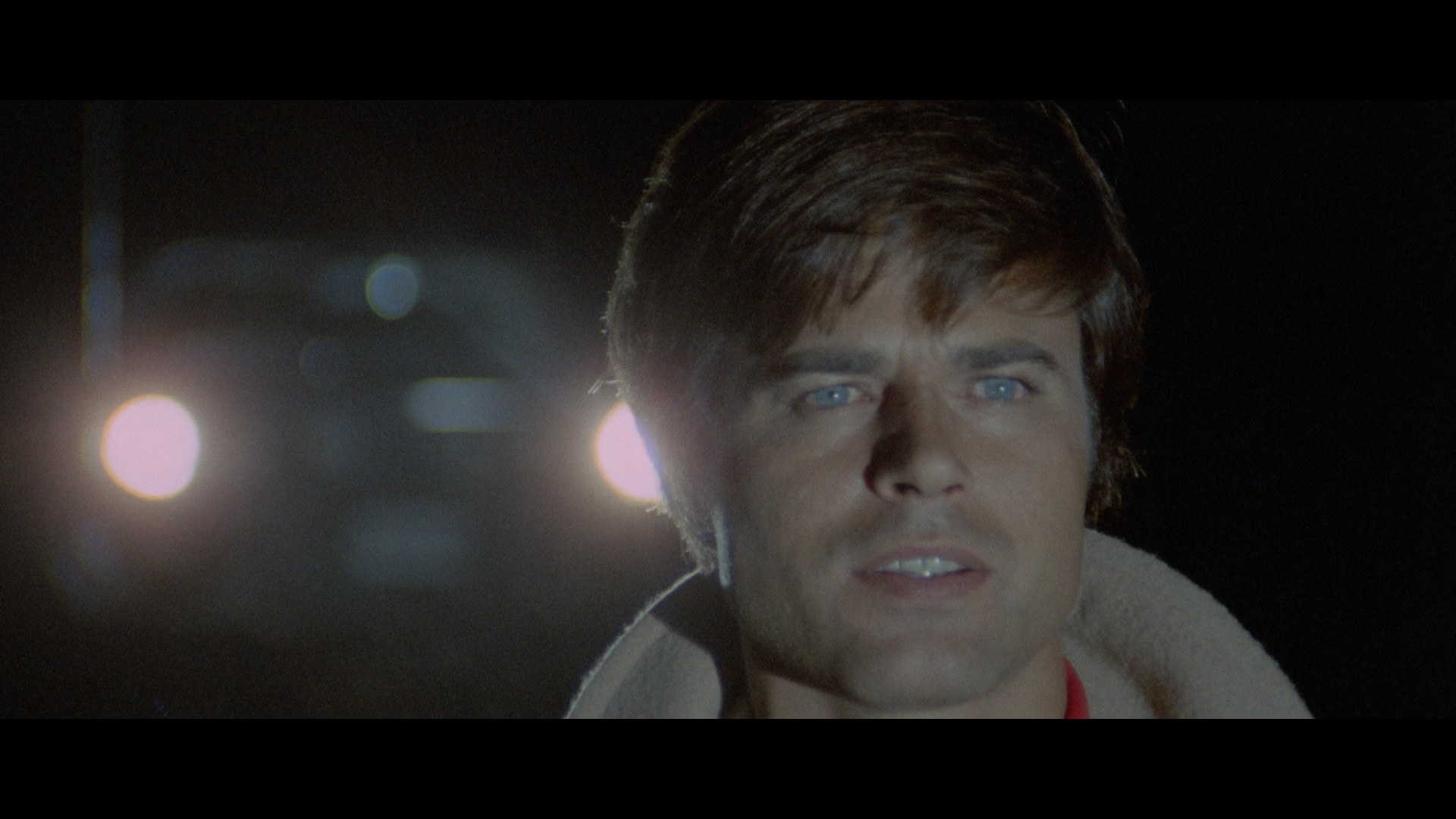 construction of the story in an environment of wealth and corruption. Also included is an alternate opening title sequence (2m7s) without the negative effect seen in the final cut and a snippet (26s) of alternate clothed footage.
construction of the story in an environment of wealth and corruption. Also included is an alternate opening title sequence (2m7s) without the negative effect seen in the final cut and a snippet (26s) of alternate clothed footage.
Later in 2020, Severin premiered the film on U.S. Blu-ray and marking its first appearance on legit American video in decades. The transfer is from the same source as the European editions and appears to be identical here, with DTS-H MA English and Italian audio options with the usual English SDH and translated options. This time you get a new audio commentary by Samm Deighan, who follows the pattern here by kicking off with a defense of Lenzi but then offers her own welcome take on the director's contributions including his focus on more exotic and country-style locales, warped romantic relationships, and his use of Baker after her frustrated experience with the studio system in Hollywood like several other actors around the same time. She also offers some interesting readings on the film's portrayal of victims and punishment while also connecting the film and its participants to other Euro films around the time and even far off in the future like Thesis. (For some reason the commentary switches over the film's English audio track at every chapter stop if you play it on the fly with your remote; make sure you select it from the main menu before starting. A similar oddity also appears to affect the Italian track on So Sweet, so again, make sure you pick your language option from the main menu instead of going back and forth during playback.) Yet another Lenzi interview, "Sex and Conspiracy" (10m51s), covers similar territory as the other disc including the locations, the twists he liked in the story, and the differences making a Spanish co-production at the time including the rental of that main swanky house. The alternate credit sequence and clothed footage are included here, plus the old Magnetic VHS opening for you nostalgic folks out there and a 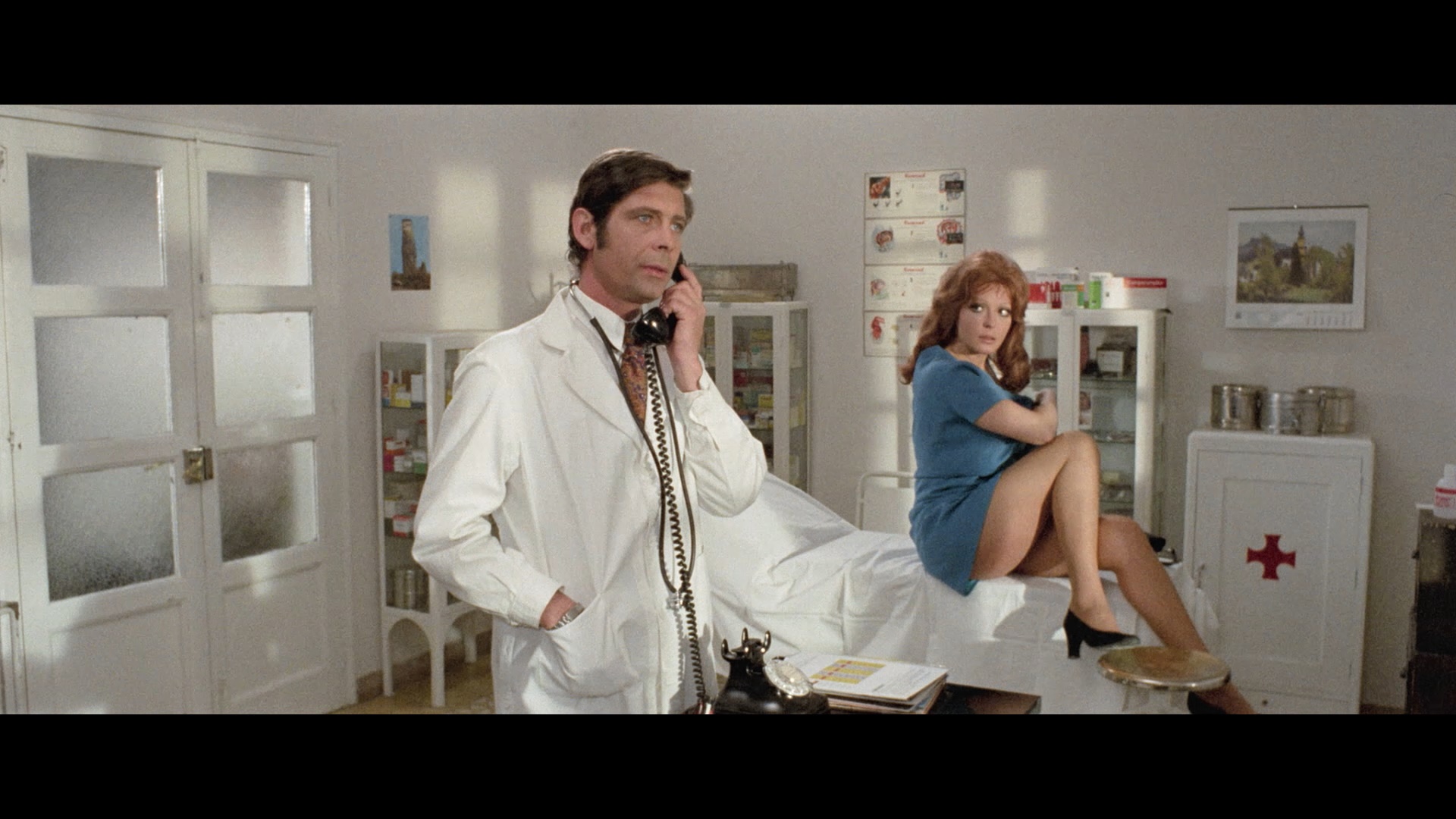 very brief (10s) "extended scene" consisting of a shot of Baker putting on her driving helmet.
very brief (10s) "extended scene" consisting of a shot of Baker putting on her driving helmet.
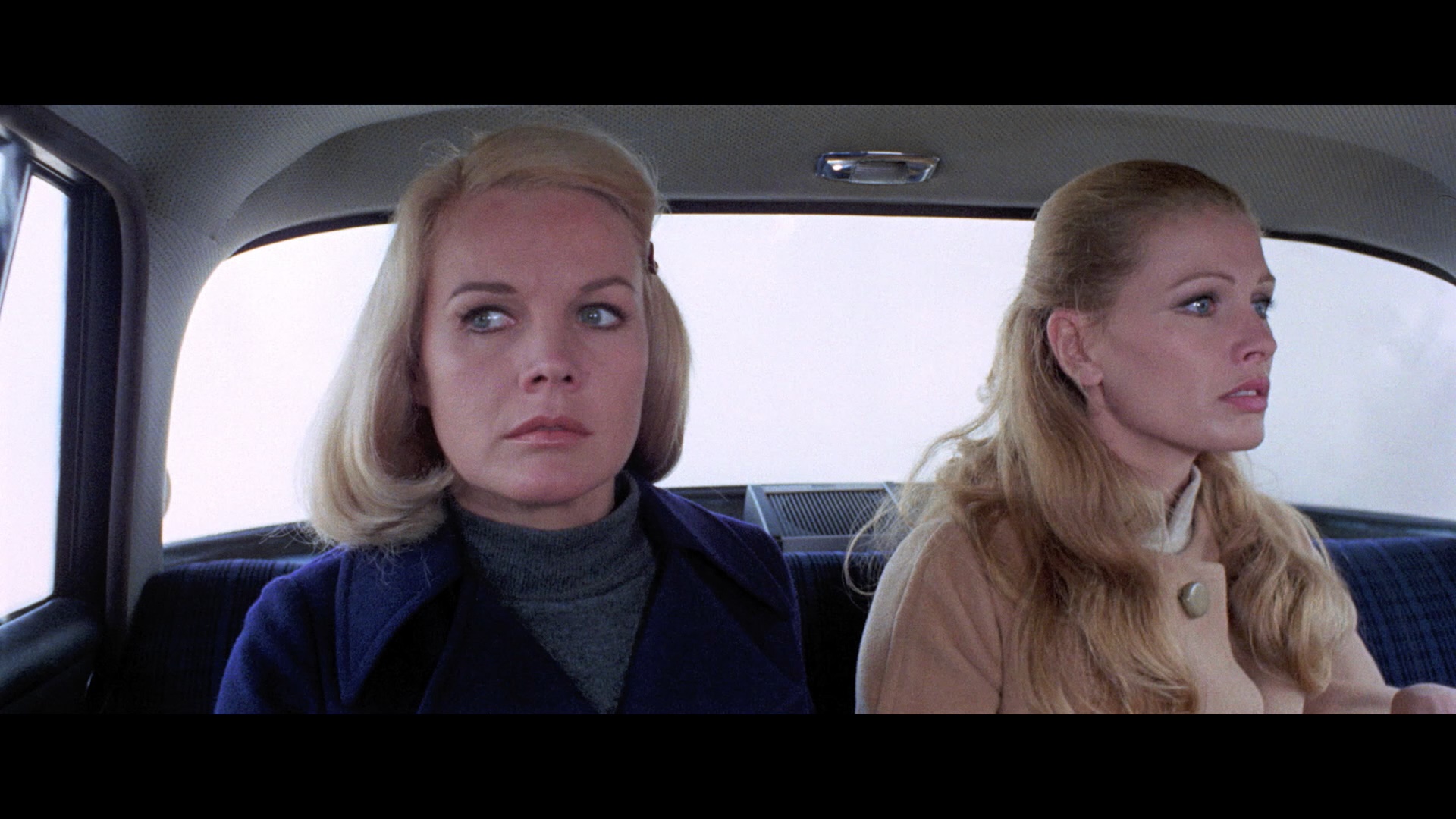 After that flurry of back-to-back Lenzi films, Baker took a break for almost two years during which she made the less interesting heist film and semi-giallo, The Devil with Seven Faces, co-starred with George Hilton. In 1972 she reunited with Lenzi for a fourth and final time with Knife of Ice, which shakes up the formula in numerous ways that will come as a particular surprise if you've been watching these films straight in a row. Here Baker plays her role almost entirely mute as Martha, who's first seen attending a particularly nasty bullfight over the main titles along with her cousin, Jenny (The Psychic's Stewart). As that bit of animal cruelty winds down we're immediately tipped off to the title thanks to a fake Edgar Allan Poe quote, "Fear is a knife of ice wich [sic] penetrates the senses down to the depth of conscience." That fear kicks into gear fairly quickly as we find out Martha's been unable to speak ever since a traumatic train crash that killed her parents. On the way home they seem to be followed by a strange man, and soon after Jenny is killed by a knife-wielding attacker in the garage at the house owned by Martha's uncle. At first the police suspect a local devil worshiper of the crime connected to another slaying in the area, but as the body count mounts, the finger of suspicion seems to be pointing to nearly anyone
After that flurry of back-to-back Lenzi films, Baker took a break for almost two years during which she made the less interesting heist film and semi-giallo, The Devil with Seven Faces, co-starred with George Hilton. In 1972 she reunited with Lenzi for a fourth and final time with Knife of Ice, which shakes up the formula in numerous ways that will come as a particular surprise if you've been watching these films straight in a row. Here Baker plays her role almost entirely mute as Martha, who's first seen attending a particularly nasty bullfight over the main titles along with her cousin, Jenny (The Psychic's Stewart). As that bit of animal cruelty winds down we're immediately tipped off to the title thanks to a fake Edgar Allan Poe quote, "Fear is a knife of ice wich [sic] penetrates the senses down to the depth of conscience." That fear kicks into gear fairly quickly as we find out Martha's been unable to speak ever since a traumatic train crash that killed her parents. On the way home they seem to be followed by a strange man, and soon after Jenny is killed by a knife-wielding attacker in the garage at the house owned by Martha's uncle. At first the police suspect a local devil worshiper of the crime connected to another slaying in the area, but as the body count mounts, the finger of suspicion seems to be pointing to nearly anyone  in sight.
in sight.
Taking a page from Robert Siodmak's The Spiral Staircase along with any number of other Gothic potboilers, Knife of Ice focuses far more on suspense and lunatic red herrings than the sexy thrills of the earlier Lenzi films. Baker stays fully clothed in this one, and even the killings are 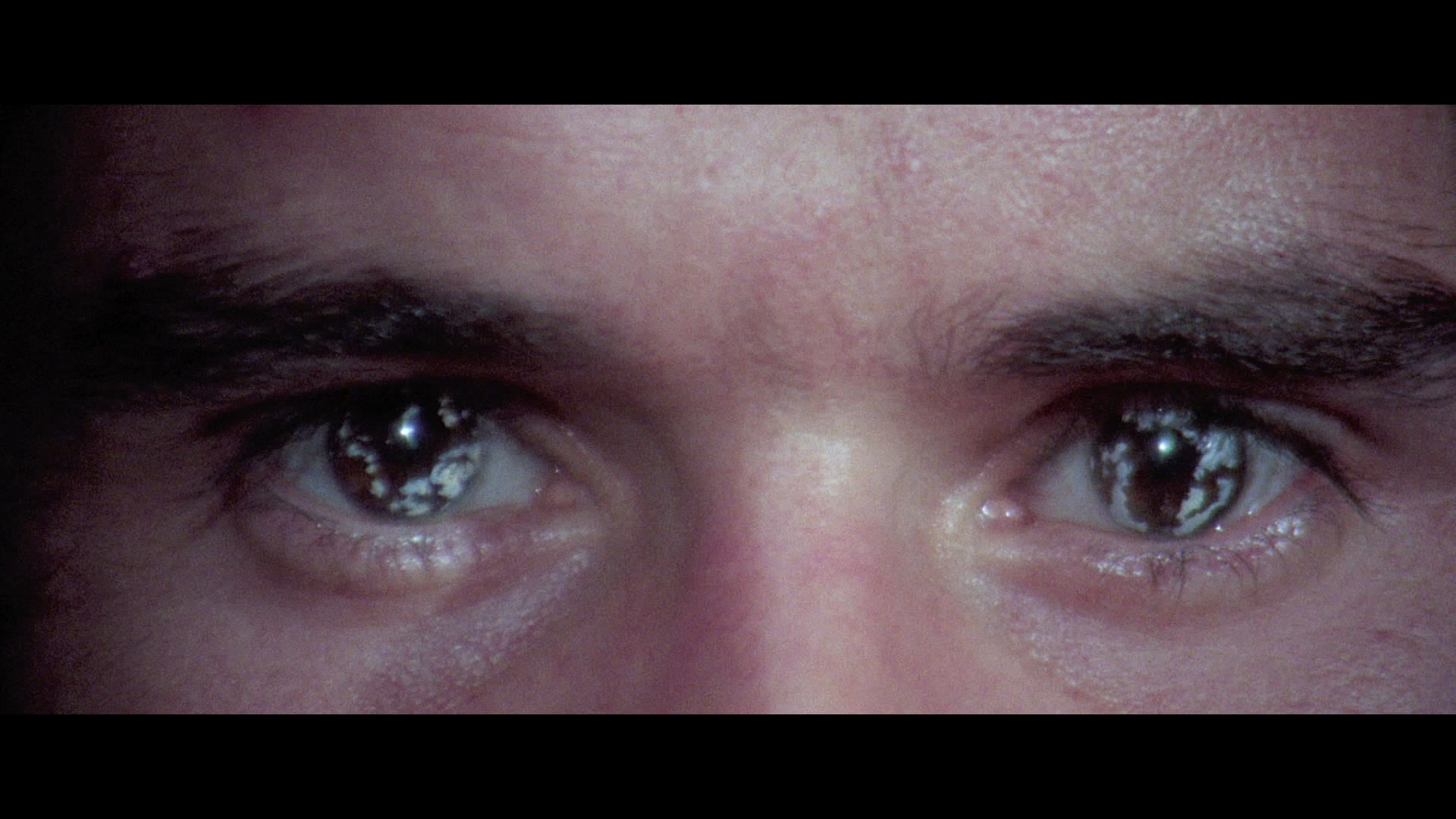 fairly subdued with most of the impact achieved through editing and a pounding music score rather than splashes of blood. The payoff is actually worth it as well with the twist ending truly breaking from the mold we've seen before, making this a nice little subversion of viewer expectations and wrapping up the Lenzi-Baker cycle on a fascinating note. Once again the locale shifts dramatically with the Spanish Pyrenees making for a pleasing and unique backdrop, and Lenzi goes a bit more nuts than usual with stylistic tricks including some crazed zooms and editing trickery taking over during the denouement for maximum feverish effect. It's also a particularly fine showcase for Baker as well, allowing her to carry the bulk of the film on her shoulders with only her eyes really conveying the web of emotions she's feeling as the stakes around her become increasingly deadly.
fairly subdued with most of the impact achieved through editing and a pounding music score rather than splashes of blood. The payoff is actually worth it as well with the twist ending truly breaking from the mold we've seen before, making this a nice little subversion of viewer expectations and wrapping up the Lenzi-Baker cycle on a fascinating note. Once again the locale shifts dramatically with the Spanish Pyrenees making for a pleasing and unique backdrop, and Lenzi goes a bit more nuts than usual with stylistic tricks including some crazed zooms and editing trickery taking over during the denouement for maximum feverish effect. It's also a particularly fine showcase for Baker as well, allowing her to carry the bulk of the film on her shoulders with only her eyes really conveying the web of emotions she's feeling as the stakes around her become increasingly deadly.
Barely released outside of Italy and Spain, Knife of Ice first appeared on DVD in Japan in 2003 from Trash Mountain complete with a pretty decent transfer and the English-language track. That 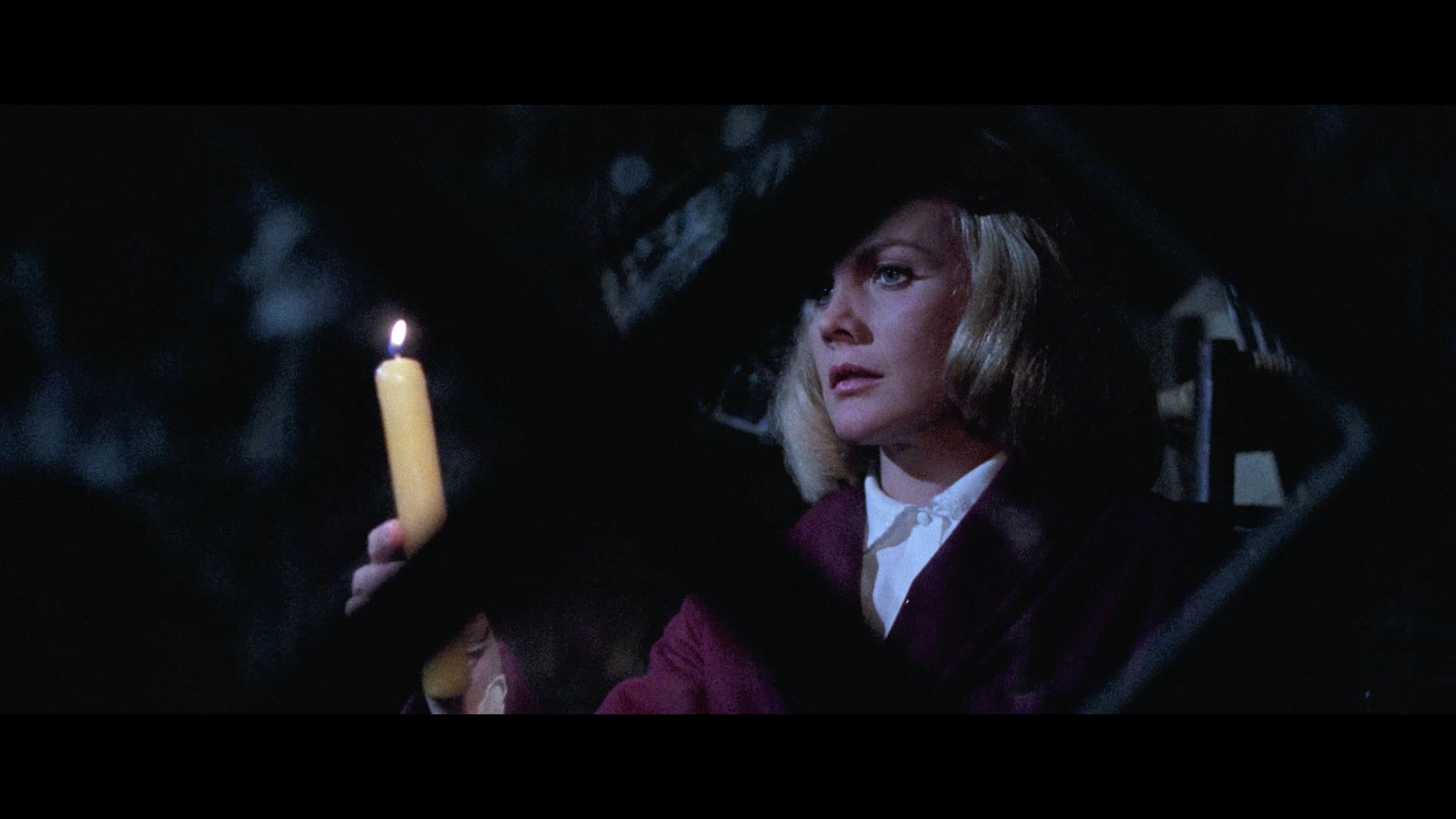 automatically made it the easiest film out of this batch to see in anything resembling a good version during the peak of the DVD era, though after that you were essentially out of luck until 2020. At one point the now notorious label Dorado Films announced the film for Blu-ray and even included
automatically made it the easiest film out of this batch to see in anything resembling a good version during the peak of the DVD era, though after that you were essentially out of luck until 2020. At one point the now notorious label Dorado Films announced the film for Blu-ray and even included 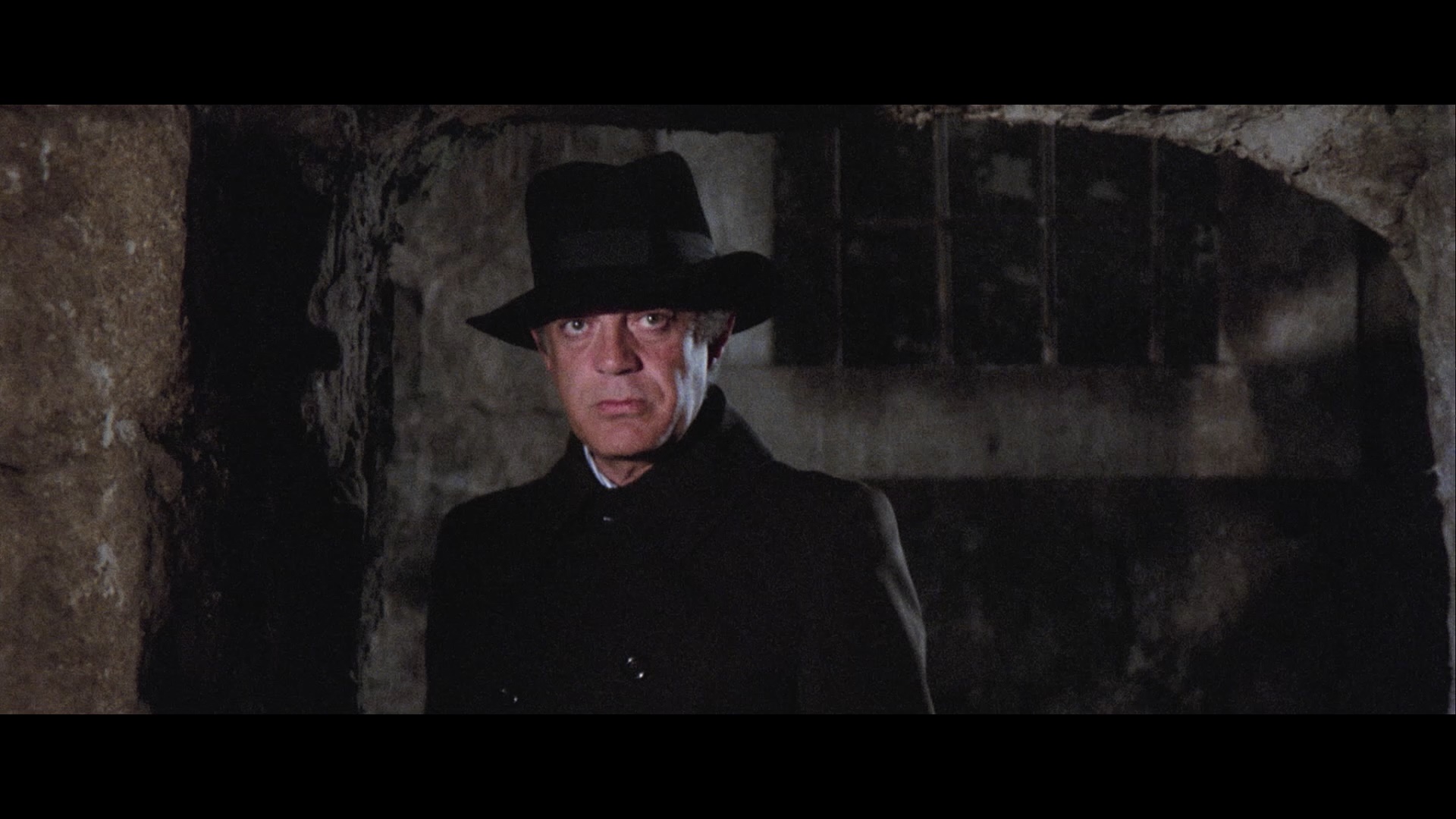 the trailer on one of its releases, but that failed to materialize (along with just about everything else they announced). Luckily the film ended up in the Severin box instead with all of its rich color intact, and it also looks quite nice with a major leap in detail compared to the DVD. The English and Italian audio options are here of course (DTS-HD MA) with the standard English SDH and translated options, both of which sound perfectly fine; in this case since you're deprived of Baker's voice, it's pretty much a toss up between the two. There's no audio commentary this time around but you do get "Carroll and Umberto's Final Stab" (29m6s) with the always articulate Stephen Thrower sketching out the history leading up to this film and offering a solid appraisal of this film's merits including its Gothic touches and the way it paved a path to Lenzi's watershed poliziotteschi that would stand among the finest work of his entire career. Speaking of Lenzi, there's one more interview with him here, "Until the Silence Screams" (18m35s), which focuses on his working relationship with Baker building up to this film, the influence of the Siodmak film, the thought process behind the final twist, and the comparatively disappointing box office reception in Europe. (He mentions a warmer reaction in the States, which is odd since it doesn't seem to have played there.) Note that the English subs on this one don't kick on automatically, so use your remote to activate them. The great, vertigo-inducing theatrical trailer is also included along with the Italian credits (in case you want to watch that poor bull again). Also, note that there's a second CD in this set included in the case for So Sweet that features not only the full Ortolani score (as presented on earlier CD and LP editions) but the world premiere of the soundtrack for A Quiet Place to Kill including the theme song and its instrumental variations; the theme only for Knife of Ice is also on the disc, pulled from the film's audio elements since the music masters have apparently been lost.
the trailer on one of its releases, but that failed to materialize (along with just about everything else they announced). Luckily the film ended up in the Severin box instead with all of its rich color intact, and it also looks quite nice with a major leap in detail compared to the DVD. The English and Italian audio options are here of course (DTS-HD MA) with the standard English SDH and translated options, both of which sound perfectly fine; in this case since you're deprived of Baker's voice, it's pretty much a toss up between the two. There's no audio commentary this time around but you do get "Carroll and Umberto's Final Stab" (29m6s) with the always articulate Stephen Thrower sketching out the history leading up to this film and offering a solid appraisal of this film's merits including its Gothic touches and the way it paved a path to Lenzi's watershed poliziotteschi that would stand among the finest work of his entire career. Speaking of Lenzi, there's one more interview with him here, "Until the Silence Screams" (18m35s), which focuses on his working relationship with Baker building up to this film, the influence of the Siodmak film, the thought process behind the final twist, and the comparatively disappointing box office reception in Europe. (He mentions a warmer reaction in the States, which is odd since it doesn't seem to have played there.) Note that the English subs on this one don't kick on automatically, so use your remote to activate them. The great, vertigo-inducing theatrical trailer is also included along with the Italian credits (in case you want to watch that poor bull again). Also, note that there's a second CD in this set included in the case for So Sweet that features not only the full Ortolani score (as presented on earlier CD and LP editions) but the world premiere of the soundtrack for A Quiet Place to Kill including the theme song and its instrumental variations; the theme only for Knife of Ice is also on the disc, pulled from the film's audio elements since the music masters have apparently been lost.
Reviewed on July 23, 2020


 ready to be thoroughly confused. In 1967,
ready to be thoroughly confused. In 1967,  American star Carroll Baker made an abrupt career shift following soapy, glitzy Hollywood productions like The Carpetbaggers and Harlow to jet off to Italy where she started appearing in a string of sexy films starting off with Marco Ferreri's The Harem. She scored a significant international hit with her next Italian feature, 1968's The Sweet Body of Deborah, which paired her up with French heartthrob Jean Sorel and really kicked off the elegant cosmopolitan giallo that would remain the standard for a couple of years until Dario Argento upended all of it in 1970. Though the giallo had been around since the pioneering works of Mario Bava (thanks to The Girl Who Knew Too Much, Blood and Black Lace, and a third of Black Sabbath), the Baker film brought it to a new level of commercial accessibility including a hefty U.S. release from none other than Warner Bros. (in its Seven Arts phase).
American star Carroll Baker made an abrupt career shift following soapy, glitzy Hollywood productions like The Carpetbaggers and Harlow to jet off to Italy where she started appearing in a string of sexy films starting off with Marco Ferreri's The Harem. She scored a significant international hit with her next Italian feature, 1968's The Sweet Body of Deborah, which paired her up with French heartthrob Jean Sorel and really kicked off the elegant cosmopolitan giallo that would remain the standard for a couple of years until Dario Argento upended all of it in 1970. Though the giallo had been around since the pioneering works of Mario Bava (thanks to The Girl Who Knew Too Much, Blood and Black Lace, and a third of Black Sabbath), the Baker film brought it to a new level of commercial accessibility including a hefty U.S. release from none other than Warner Bros. (in its Seven Arts phase).  spouting Marxist ideology and seducing Kathryn whenever he has the chance. Of course, it soon
spouting Marxist ideology and seducing Kathryn whenever he has the chance. Of course, it soon  becomes a perverse love triangle with the seemingly innocent Eva's true colors coming out and Kathryn becoming a prisoner in her own home after the partying and drinking have died down.
becomes a perverse love triangle with the seemingly innocent Eva's true colors coming out and Kathryn becoming a prisoner in her own home after the partying and drinking have died down.  story made a lot more sense instead of the abrupt and almost hysterically depressing resolution of the U.S. cut, and that version was later
story made a lot more sense instead of the abrupt and almost hysterically depressing resolution of the U.S. cut, and that version was later  issued on Italian DVD (albeit with no English-friendly options at all). After that it was a long, long wait until the 2020 Blu-ray debut from Severin Films as part of the limited, six-disc set, The Complete Lenzi Baker Giallo Collection, which compiles all four of their features along with two bonus CDs. (The set is also available as a limited bundle featuring a T-shirt and postcards, while early orders also got an Italian comic reproduction for the second film in the set.) The first CD contains, for the first time ever in any format, the full soundtrack for Paranoia; prior to this we only had the two songs ("Just Tell Me" and Lydia MacDonald's "Fate Had Planned It So") as scarce Italian 45 vinyl singles, but now you get everything including the entire Umiliani score (with most of it in gorgeous stereo). A miracle of rights hurdling on so many fronts, the box is an obvious labor of love that brings together a cycle that many had given up ever seeing being given the deluxe treatment anywhere in the world, and to start things off right, Paranoia is presented in full scope in both its Italian and U.S. cuts for the first time anywhere. Even better, you can finally watch the Italian cut at last with option of an English track integrated wherever possible with subtitled Italian used for that original extended ending. The Italian audio is also present with optional English translated subtitles, while the U.S. cut comes with English SDH subtitles. Shot in Techniscope and most often seen over the past few decades in terrible, ragged prints, this film doesn't look as polished or slick as its successors with fading, chunkiness, and softness in evidence, but this is easily the best it's ever looked on home video and far superior to the very mangled surviving U.S. prints barely floating around out there. The two audio commentaries it contains can't really be evaluated here as one of them (for the U.S. cut) features this writer and Troy Howarth but you will hopefully find it enjoyable; the Italian version comes with an audio commentary by Alexandra Heller-Nicholas who focuses on rebutting the labeling of Lenzi as a hack and chats about the origins of the giallo. In "Giallo Fever" (11m1s), an interview with the late Lenzi covers the development of the script, the French involvement, the story behind the title change (complicated by the fact that this was originally intended to be called Paranoia before the Italian producer
issued on Italian DVD (albeit with no English-friendly options at all). After that it was a long, long wait until the 2020 Blu-ray debut from Severin Films as part of the limited, six-disc set, The Complete Lenzi Baker Giallo Collection, which compiles all four of their features along with two bonus CDs. (The set is also available as a limited bundle featuring a T-shirt and postcards, while early orders also got an Italian comic reproduction for the second film in the set.) The first CD contains, for the first time ever in any format, the full soundtrack for Paranoia; prior to this we only had the two songs ("Just Tell Me" and Lydia MacDonald's "Fate Had Planned It So") as scarce Italian 45 vinyl singles, but now you get everything including the entire Umiliani score (with most of it in gorgeous stereo). A miracle of rights hurdling on so many fronts, the box is an obvious labor of love that brings together a cycle that many had given up ever seeing being given the deluxe treatment anywhere in the world, and to start things off right, Paranoia is presented in full scope in both its Italian and U.S. cuts for the first time anywhere. Even better, you can finally watch the Italian cut at last with option of an English track integrated wherever possible with subtitled Italian used for that original extended ending. The Italian audio is also present with optional English translated subtitles, while the U.S. cut comes with English SDH subtitles. Shot in Techniscope and most often seen over the past few decades in terrible, ragged prints, this film doesn't look as polished or slick as its successors with fading, chunkiness, and softness in evidence, but this is easily the best it's ever looked on home video and far superior to the very mangled surviving U.S. prints barely floating around out there. The two audio commentaries it contains can't really be evaluated here as one of them (for the U.S. cut) features this writer and Troy Howarth but you will hopefully find it enjoyable; the Italian version comes with an audio commentary by Alexandra Heller-Nicholas who focuses on rebutting the labeling of Lenzi as a hack and chats about the origins of the giallo. In "Giallo Fever" (11m1s), an interview with the late Lenzi covers the development of the script, the French involvement, the story behind the title change (complicated by the fact that this was originally intended to be called Paranoia before the Italian producer  went for Orgasmo instead), and a few amusing additional tangents about his creative process
went for Orgasmo instead), and a few amusing additional tangents about his creative process  on other films like Kriminal and Brothers Till We Die. The U.S. trailer is also included.
on other films like Kriminal and Brothers Till We Die. The U.S. trailer is also included.  in his marital status, it soon turns out that there's
in his marital status, it soon turns out that there's  something far more deadly at work behind the scenes.
something far more deadly at work behind the scenes.  Audio is
Audio is  provided in English and Italian DTS-HD MA mono options with optional English-translated or English SDH subtitles; the English track is going to be preferable for most viewers since some (but not all) of the actors provide their own voices and were speaking English on the set, but the Italian version has its own points of interest including more poetic dialogue and a few variations in meaning with some of the line deliveries. The film can also be played with a new audio commentary by Kat Ellinger, who absolutely knocks it out of the park here; it's one of her very best giallo-centric tracks with an upbeat, razor-sharp focus on the film that encompasses connections to Lenzi's non-genre cinema, the parallels between Baker's own nervous breakdowns compared to her character's back story here, the importance of Gastaldi's narrative, and the merits of these often overlooked films in between the heydays of Bava and Argento. Engaged, perceptive, and entertaining, it's a great way to increase your appreciation of this film on numerous fronts. As for video extras, "Lenzi's Lenses" (9m5s) is a "backstage chat" with the director at the 1999 Nocturno Film Festival, chatting about shooting the film in Paris, the importance of Italian-French teamings in his career, his favorite actors and genres, and this title's particular significance in his memory including his issues with the later stretch of the location shooting. Then the brief "Equilateral Triangle" (5m59s) features Gastaldi recalling his somewhat turbulent relationship with the Tuscan director who had become "touchy and tense" at the height of his career. Also tucked away in the main menu (and barely hidden) is a reel of Italian newsreel and TV coverage (7m30s) on Baker focusing on her portrayal of Jean Harlow and Baby Doll. Finally you get the English and Italian trailers and the Italian main titles.
provided in English and Italian DTS-HD MA mono options with optional English-translated or English SDH subtitles; the English track is going to be preferable for most viewers since some (but not all) of the actors provide their own voices and were speaking English on the set, but the Italian version has its own points of interest including more poetic dialogue and a few variations in meaning with some of the line deliveries. The film can also be played with a new audio commentary by Kat Ellinger, who absolutely knocks it out of the park here; it's one of her very best giallo-centric tracks with an upbeat, razor-sharp focus on the film that encompasses connections to Lenzi's non-genre cinema, the parallels between Baker's own nervous breakdowns compared to her character's back story here, the importance of Gastaldi's narrative, and the merits of these often overlooked films in between the heydays of Bava and Argento. Engaged, perceptive, and entertaining, it's a great way to increase your appreciation of this film on numerous fronts. As for video extras, "Lenzi's Lenses" (9m5s) is a "backstage chat" with the director at the 1999 Nocturno Film Festival, chatting about shooting the film in Paris, the importance of Italian-French teamings in his career, his favorite actors and genres, and this title's particular significance in his memory including his issues with the later stretch of the location shooting. Then the brief "Equilateral Triangle" (5m59s) features Gastaldi recalling his somewhat turbulent relationship with the Tuscan director who had become "touchy and tense" at the height of his career. Also tucked away in the main menu (and barely hidden) is a reel of Italian newsreel and TV coverage (7m30s) on Baker focusing on her portrayal of Jean Harlow and Baby Doll. Finally you get the English and Italian trailers and the Italian main titles.  In 1970,
In 1970,  Lenzi and Baker really started confusing everyone by making a third giallo whose Italian title was Paranoia, a concession to that earlier film's success in America. On top of that, this film brought Baker and Sorel back together after Sweet Body and reused a key song from Orgasmo, "Just Tell Me;" for the American release, the distributor did their best to distinguish this new film by calling it A Quiet Place to Kill. Apparently determined to wreak as much havoc on viewers' sanity as possible, Lenzi followed this up with a non-Baker giallo, An Ideal Place to Kill, which had a role originally written for Baker (ultimately played by Irene Papas) and basically retold the story of Orgasmo from the two counterculture kids' point of view.
Lenzi and Baker really started confusing everyone by making a third giallo whose Italian title was Paranoia, a concession to that earlier film's success in America. On top of that, this film brought Baker and Sorel back together after Sweet Body and reused a key song from Orgasmo, "Just Tell Me;" for the American release, the distributor did their best to distinguish this new film by calling it A Quiet Place to Kill. Apparently determined to wreak as much havoc on viewers' sanity as possible, Lenzi followed this up with a non-Baker giallo, An Ideal Place to Kill, which had a role originally written for Baker (ultimately played by Irene Papas) and basically retold the story of Orgasmo from the two counterculture kids' point of view.  García Segura complete with the obligatory theme song, in this case "You" performed by Canadian singer-actress Shirley Harmer. It's worth noting that this opened shortly
García Segura complete with the obligatory theme song, in this case "You" performed by Canadian singer-actress Shirley Harmer. It's worth noting that this opened shortly  before Sergio Martino's first giallo, The Strange Vice of Mrs. Wardh, which feels very much like an evolution of the Lenzi cycle with the sex and violence amped up a bit to keep up with the times. Interestingly, this one also features way more exposure of Ms. Baker than the more famous, other Paranoia, though some audiences (and VHS consumers) got prints with alternate clothed takes of a few shots in keeping with Spanish cinematic practice at the time.
before Sergio Martino's first giallo, The Strange Vice of Mrs. Wardh, which feels very much like an evolution of the Lenzi cycle with the sex and violence amped up a bit to keep up with the times. Interestingly, this one also features way more exposure of Ms. Baker than the more famous, other Paranoia, though some audiences (and VHS consumers) got prints with alternate clothed takes of a few shots in keeping with Spanish cinematic practice at the time.  well as the
well as the  construction of the story in an environment of wealth and corruption. Also included is an alternate opening title sequence (2m7s) without the negative effect seen in the final cut and a snippet (26s) of alternate clothed footage.
construction of the story in an environment of wealth and corruption. Also included is an alternate opening title sequence (2m7s) without the negative effect seen in the final cut and a snippet (26s) of alternate clothed footage.  very brief (10s) "extended scene" consisting of a shot of Baker putting on her driving helmet.
very brief (10s) "extended scene" consisting of a shot of Baker putting on her driving helmet.  After that flurry of back-to-back Lenzi films, Baker took a break for almost two years during which she made the less interesting heist film and semi-giallo, The Devil with Seven Faces, co-starred with George Hilton. In 1972 she reunited with Lenzi for a fourth and final time with Knife of Ice, which shakes up the formula in numerous ways that will come as a particular surprise if you've been watching these films straight in a row. Here Baker plays her role almost entirely mute as Martha, who's first seen attending a particularly nasty bullfight over the main titles along with her cousin, Jenny (The Psychic's Stewart). As that bit of animal cruelty winds down we're immediately tipped off to the title thanks to a fake Edgar Allan Poe quote, "Fear is a knife of ice wich [sic] penetrates the senses down to the depth of conscience." That fear kicks into gear fairly quickly as we find out Martha's been unable to speak ever since a traumatic train crash that killed her parents. On the way home they seem to be followed by a strange man, and soon after Jenny is killed by a knife-wielding attacker in the garage at the house owned by Martha's uncle. At first the police suspect a local devil worshiper of the crime connected to another slaying in the area, but as the body count mounts, the finger of suspicion seems to be pointing to nearly anyone
After that flurry of back-to-back Lenzi films, Baker took a break for almost two years during which she made the less interesting heist film and semi-giallo, The Devil with Seven Faces, co-starred with George Hilton. In 1972 she reunited with Lenzi for a fourth and final time with Knife of Ice, which shakes up the formula in numerous ways that will come as a particular surprise if you've been watching these films straight in a row. Here Baker plays her role almost entirely mute as Martha, who's first seen attending a particularly nasty bullfight over the main titles along with her cousin, Jenny (The Psychic's Stewart). As that bit of animal cruelty winds down we're immediately tipped off to the title thanks to a fake Edgar Allan Poe quote, "Fear is a knife of ice wich [sic] penetrates the senses down to the depth of conscience." That fear kicks into gear fairly quickly as we find out Martha's been unable to speak ever since a traumatic train crash that killed her parents. On the way home they seem to be followed by a strange man, and soon after Jenny is killed by a knife-wielding attacker in the garage at the house owned by Martha's uncle. At first the police suspect a local devil worshiper of the crime connected to another slaying in the area, but as the body count mounts, the finger of suspicion seems to be pointing to nearly anyone  in sight.
in sight. fairly subdued with most of the impact achieved through editing and a pounding music score rather than splashes of blood. The payoff is actually worth it as well with the twist ending truly breaking from the mold we've seen before, making this a nice little subversion of viewer expectations and wrapping up the Lenzi-Baker cycle on a fascinating note. Once again the locale shifts dramatically with the Spanish Pyrenees making for a pleasing and unique backdrop, and Lenzi goes a bit more nuts than usual with stylistic tricks including some crazed zooms and editing trickery taking over during the denouement for maximum feverish effect. It's also a particularly fine showcase for Baker as well, allowing her to carry the bulk of the film on her shoulders with only her eyes really conveying the web of emotions she's feeling as the stakes around her become increasingly deadly.
fairly subdued with most of the impact achieved through editing and a pounding music score rather than splashes of blood. The payoff is actually worth it as well with the twist ending truly breaking from the mold we've seen before, making this a nice little subversion of viewer expectations and wrapping up the Lenzi-Baker cycle on a fascinating note. Once again the locale shifts dramatically with the Spanish Pyrenees making for a pleasing and unique backdrop, and Lenzi goes a bit more nuts than usual with stylistic tricks including some crazed zooms and editing trickery taking over during the denouement for maximum feverish effect. It's also a particularly fine showcase for Baker as well, allowing her to carry the bulk of the film on her shoulders with only her eyes really conveying the web of emotions she's feeling as the stakes around her become increasingly deadly.  automatically made it the easiest film out of this batch to see in anything resembling a good version during the peak of the DVD era, though after that you were essentially out of luck until 2020. At one point the now notorious label Dorado Films announced the film for Blu-ray and even included
automatically made it the easiest film out of this batch to see in anything resembling a good version during the peak of the DVD era, though after that you were essentially out of luck until 2020. At one point the now notorious label Dorado Films announced the film for Blu-ray and even included  the trailer on one of its releases, but that failed to materialize (along with just about everything else they announced). Luckily the film ended up in the Severin box instead with all of its rich color intact, and it also looks quite nice with a major leap in detail compared to the DVD. The English and Italian audio options are here of course (DTS-HD MA) with the standard English SDH and translated options, both of which sound perfectly fine; in this case since you're deprived of Baker's voice, it's pretty much a toss up between the two. There's no audio commentary this time around but you do get "Carroll and Umberto's Final Stab" (29m6s) with the always articulate Stephen Thrower sketching out the history leading up to this film and offering a solid appraisal of this film's merits including its Gothic touches and the way it paved a path to Lenzi's watershed poliziotteschi that would stand among the finest work of his entire career. Speaking of Lenzi, there's one more interview with him here, "Until the Silence Screams" (18m35s), which focuses on his working relationship with Baker building up to this film, the influence of the Siodmak film, the thought process behind the final twist, and the comparatively disappointing box office reception in Europe. (He mentions a warmer reaction in the States, which is odd since it doesn't seem to have played there.) Note that the English subs on this one don't kick on automatically, so use your remote to activate them. The great, vertigo-inducing theatrical trailer is also included along with the Italian credits (in case you want to watch that poor bull again). Also, note that there's a second CD in this set included in the case for So Sweet that features not only the full Ortolani score (as presented on earlier CD and LP editions) but the world premiere of the soundtrack for A Quiet Place to Kill including the theme song and its instrumental variations; the theme only for Knife of Ice is also on the disc, pulled from the film's audio elements since the music masters have apparently been lost.
the trailer on one of its releases, but that failed to materialize (along with just about everything else they announced). Luckily the film ended up in the Severin box instead with all of its rich color intact, and it also looks quite nice with a major leap in detail compared to the DVD. The English and Italian audio options are here of course (DTS-HD MA) with the standard English SDH and translated options, both of which sound perfectly fine; in this case since you're deprived of Baker's voice, it's pretty much a toss up between the two. There's no audio commentary this time around but you do get "Carroll and Umberto's Final Stab" (29m6s) with the always articulate Stephen Thrower sketching out the history leading up to this film and offering a solid appraisal of this film's merits including its Gothic touches and the way it paved a path to Lenzi's watershed poliziotteschi that would stand among the finest work of his entire career. Speaking of Lenzi, there's one more interview with him here, "Until the Silence Screams" (18m35s), which focuses on his working relationship with Baker building up to this film, the influence of the Siodmak film, the thought process behind the final twist, and the comparatively disappointing box office reception in Europe. (He mentions a warmer reaction in the States, which is odd since it doesn't seem to have played there.) Note that the English subs on this one don't kick on automatically, so use your remote to activate them. The great, vertigo-inducing theatrical trailer is also included along with the Italian credits (in case you want to watch that poor bull again). Also, note that there's a second CD in this set included in the case for So Sweet that features not only the full Ortolani score (as presented on earlier CD and LP editions) but the world premiere of the soundtrack for A Quiet Place to Kill including the theme song and its instrumental variations; the theme only for Knife of Ice is also on the disc, pulled from the film's audio elements since the music masters have apparently been lost.